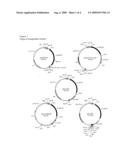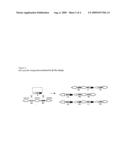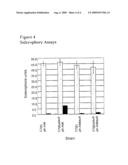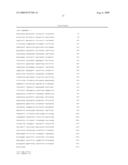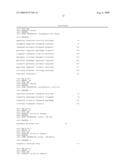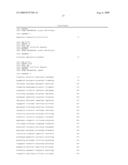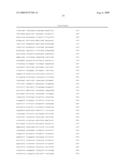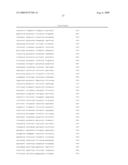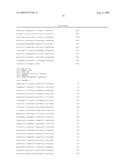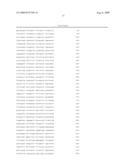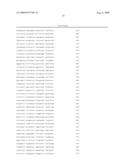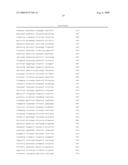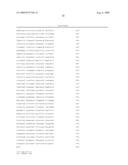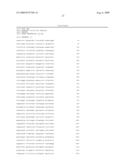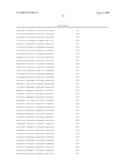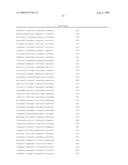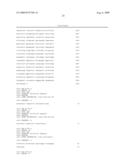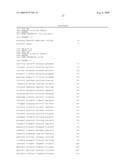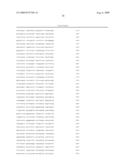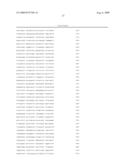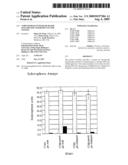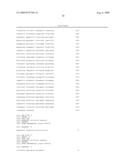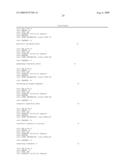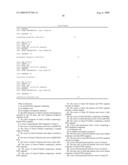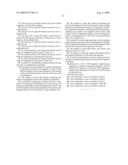Patent application title: Corynephage integrase-based site-specific insertion vector system
Inventors:
Diana M. Oram (Ellicott City, MD, US)
Mark Oram (Ellicott City, MD, US)
Joelle Woolston (Baltimore, MD, US)
IPC8 Class: AC12P2100FI
USPC Class:
435 693
Class name: Micro-organism, tissue cell culture or enzyme using process to synthesize a desired chemical compound or composition recombinant dna technique included in method of making a protein or polypeptide antigens
Publication date: 2009-08-06
Patent application number: 20090197304
Claims:
1. An isolated DNA fragment comprising(a) an integrase and(b) an
integrase-recognition sequence.
2. The DNA fragment of claim 1 wherein said integrase is encoded by the int gene and said integrase-recognition sequence is attP.
3. The DNA fragment of claim 2 further comprising a desired DNA segment.
4. A vector comprising the DNA fragment of claim 2.
5. The vector of claim 4 wherein said vector is pKMO3W.
6. The vector of claim 4 further comprising a conjugal origin of transfer.
7. The vector of claim 6 wherein said origin of transfer is oriT.
8. The vector of claim 7 wherein said vector is pKMO3W+mob.
9. The vector of claim 7 wherein said vector is pK-AIM.
10. The vector of claim 6 further comprising a desired DNA segment.
11. The vector of claim 8 further comprising a desired DNA segment.
12. The vector of claim 9 further comprising a desired DNA segment.
13. The vector of claim 12 wherein said DNA segment encodes an antigen.
14. The vector of claim 12 wherein said DNA segment encodes a mutant antigen.
15. The vector of claim 13 wherein said vector is pK-AIMdtR.
16. The vector of claim 9 further comprising a polylinker.
17. The vector of claim 16 wherein said vector is pK-PIM.
18. The vector of claim 17 further comprising a desired DNA segment.
19. A host cell transformed with a vector comprising a DNA fragment comprising(a) an integrase and(b) an integrase-recognition sequence.
20. The host cell of claim 19 wherein said vector further comprises a desired DNA segment.
21. The host cell of claim 20 wherein said DNA segment encodes an antigen.
22. A host cell transformed with the vector of claim 4.
23. The host cell of claim 22 wherein said vector further comprises a desired DNA segment.
24. A host cell transformed with the vector of claim 9.
25. The host cell of claim 24 wherein said vector further comprises a desired DNA segment.
26. A host cell transformed with the vector of claim 17.
27. The host cell of claim 26 wherein said vector further comprises a desired DNA segment.
28. The host cell of claim 19 wherein said host cell is a corynebacteria.
29. The host cell of claim 19 wherein said host cell is a bacterial cell.
30. The host cell of claim 29 wherein said bacteria is chosen from the group consisting of Gram-positive, Gram-negative, and mycobacterium.
31. The host cell of claim 19 wherein said host cell is a vertebrate cell.
32. The host cell of claim 19 wherein said host cell is a mammalian cell.
33. An isolated bacterial cell wherein the nucleic acid of claim 3 is integrated into the genome of the cell.
34. An isolated vertebrate cell wherein the nucleic acid of claim 3 is integrated into the genome of the cell.
35. An isolate mammalian cell wherein the nucleic acid of claim 3 is integrated into the genome of the cell.
36. A method for introducing a desired nucleic acid segment into a corynebacteria comprisingintroducing into the corynebacteria a nucleic acid fragment comprising the nucleic acid fragment of claim 3, such that the integrase catalyzes the integration of the desired nucleic acid fragment in the cell at an attB locus in the corynebacteria.
37. The method of claim 36, wherein introducing the nucleic acid fragment into the cell comprises conjugation.
38. A method for introducing a nucleic acid into a vertebrate cell comprising introducing into the cell a nucleic acid fragment comprising a nucleic acid fragment of claim 3, such that the integrase catalyzes the integration of the nucleic acid fragment in the cell at an attB locus in said vertebrate cell.
39. The method of claim 38, wherein introducing the nucleic acid fragment into the cell comprises using a method selected from the group consisting of: conjugation, transfection, natural transformation, microinjection, electroporation, combining the nucleic acid fragment with cationic lipid vesicles or DNA condensing reagents, and incorporating the nucleic acid fragment into a viral vector and contacting the viral vector with the cell.
40. A method for transferring a gene into a cell comprising introducing into said cell a nucleic acid fragment according to claim 3, such that the integrase catalyzes the integration of the desired DNA segment into the genome of the cell.
41. The method of claim 40 wherein said nucleic acid fragment is part of a vector.
42. The method of claim 41, wherein the desired nucleic acid segment integrated is expressed in the genome.
43. A method for producing a vaccine in a cell wherein said vaccine is an antigen expressed from a desired DNA segment, comprisingintroducing into a cell a DNA fragment comprising an integrase, an integrase-recognition sequence, and the desired DNA segment, such that the DNA segment is integrated into the genome of said cell, and said antigen is expressed; andcollecting said antigen.
44. A kit comprising a vector according to claim 4.
45. A kit comprising a vector according to claim 6.
46. A kit comprising a vector according to claim 7.
47. A kit comprising a vector according to claim 16.
48. A kit comprising a vector according to claim 17.
Description:
[0001]This application claims benefit of priority from Provisional
Application Ser. No. 60/844,946 filed on Sep. 15, 2006.
[0003]Corynebacterium diphtheriae is a human pathogen and the causative agent of diphtheria. While all C. diphtheriae strains are capable of colonizing humans, only those that produce diphtheria toxin (DT) cause the life-threatening toxin-mediated manifestations of the disease (Holmes, R. K., 2000, J. Infect. Dis. 181 Suppl. 1, S156-167). Immunization with formaldehyde-treated DT leads to induction of a protective antitoxic immune response to diphtheria, although antitoxin levels wane over time and periodic re-immunization is required to maintain immunity. Diphtheria continues to pose a significant health threat both in certain sub-tropical and tropical countries where C. diphtheriae is endemic and in areas where a significant proportion of the population lacks or has failed to maintain full immunity. Indeed, loss of protective levels of antitoxin in the adult population was one major contributing factor to the diphtheria epidemic in the 1990's in the former Soviet Union (Golaz et al., 2000, J. Infect. Dis. 181, Suppl 1, S237-243; Mattos-Guaraldi et al., 2003, Mem. Inst. Oswaldo Cruz 98, 987-993).
[0004]The tox gene encoding DT is carried on various temperate corynephages, such as β, which integrate into the C. diphtheriae chromosome during the lysogenic phase of the infective cycle (Holmes, 2000, supra). The expression of tox in lysogens is regulated by the chromosomally-encoded dtxR gene product in response to Fe2+ levels (Schmitt and Holmes, 1991, Infect. Immun. 59, 1899-1904; Boyd et al., 1990, PNAS USA 87, 5968-5972). The DtxR protein, when complexed with Fe2+, binds to the tox promoter and represses transcription of tox. Conversely, when iron is limiting, the un-complexed form of DtxR is unable to bind DNA, leading to induction of DT as a consequence of iron starvation. In addition to its role in DT production, DtxR is a global regulator of gene expression, regulating the expression of multiple genes involved in iron metabolism, protection against oxidative stress, and pathogenesis (Schmitt et al., 1997, Infect. Immun. 65, 5364-5367; Schmitt, 1997, Infect. Immun. 65, 4634-4641; Schmitt and Holmes, 1994, J. Bacteriol. 176, 1141-1149; Lee et al., 1997, Infect. Immun., 65, 4273-4280; Kunkle and Schmitt, 2003, J. Bacteriol. 185, 6826-6840). DtxR is also the prototype member of a large family of bacterial gene regulators found in numerous medically relevant bacterial species, and the proteins of this family share structural and functional similarities (Feese et al., 2001, In Messerschmidt et al. (eds) Handbook of Metalloproteins, John Wiley and Sons, Chichester, pp. 850-863).
[0005]Characterizing DtxR-dependent pathways at the molecular level is pivotal in understanding the (linked) phenomena of diphtheria pathogenesis, the mechanisms of iron-dependent gene expression, and responses to oxidative stress. However, until recently there was a distinct lack of tools for defined and targeted manipulation of chromosomal DNA in C. diphtheriae and other Coryneform bacteria. Early investigations of C. diphtheriae gene function relied on random chemical mutagenesis or the cloning of C. diphtheriae genes in E. coli. An additional technical challenge to overcome is that direct transformation of Corynebacterium species with DNA is significantly hampered by both the relatively impermeable Coryneform cell wall, as well as host DNA restriction barriers (Puech et al., 2001, Microbiol. 147, 1365-1382). Despite these drawbacks, some key results have recently extended the systems available for genetic manipulation of C. diphtheriae. First pNG2, a plasmid capable of replicating in C. diphtheriae has been isolated and characterized (Tauch et al., 2003, Plasmid 49, 63-74). Second, conjugal transfer of DNA from an E. coli donor to a C. diphtheriae recipient (followed by integration of the transferred DNA into the chromosome via homologous recombination) has been reported (Ton-That et al., 2004, Mol. Microbiol. 53, 251-261); providing an alternative to electroporation as a mechanism for introducing foreign DNA into the C. diphtheriae cytoplasm. Third, the homologous recombination pathway has also been exploited in a targeted allelic exchange method; where plasmids carrying a portion of a Corynebacterium gene, when transformed into C. diphtheriae or C. ulcerans, were capable of integrating into the chromosome (Schmitt and Drazek, 2001, J. Bacteriol. 183, 1476-1481). Fourth, use of the Tn5 transpososome system for mutagenesis resulted in isolation of the first marked mutations in C. diphtheriae; the first characterization of a dtxR null mutant, and the demonstration that DtxR is not essential for cell survival (Oram et al., 2002, J. Bacteriol. 184, 5723-5732). Following on from these advances, the recently determined genome sequence of a pathogenic C. diphtheriae clinical isolate, NCTC13129 (Cerfeno-Tarraga et al., 2003, Nucl. Acid Res. 31, 6516-6523) will aid further genetic studies of C. diphtheriae.
[0006]In other bacterial systems, the availability of a genome sequence has facilitated the development of vector systems for the targeted insertion of DNA. Such systems typically exploit the integrase protein and attP site of temperate bacteriophages, or prophages identified by genomics studies. When the vector is introduced into the host cytoplasm the phage integrase protein catalyses a site-specific recombination reaction between the vector-borne attP site and the chromosomal attB locus. This generates the recombinant attL and attR sites and causes integration of the vector (which can include virtually any foreign DNA sequence) into the chromosome. Some notable examples using this methodology include the stable transformation of Mycobacterium tuberculosis, Mycobacterium smegmatis and BCG strains using the tyrosine integrase proteins of φRv1 or L5 (Kee et al., 1991, PNAS USA 88, 3111-3115; Bibb and Hatfull, 2002, Mol. Microbiol. 45, 1515-1526). Additionally, the serine integrase protein from Streptomyces phage Φ31 has been used in the construction of an integration vector capable of integrating DNA into eukaryotic chromosomes, with great potential for use in gene therapy (Groth et al., 2000, PNAS USA 97, 5995-6000). Most relevant to the current work is the description of a vector utilizing the integrase protein and attP site from the C. glutamicum corynephage Φ16 (Moreau et al., 1999, Microbiol. 145, 439-548) that transformed C. glutamicum host strains. In addition, a strain of Arthrobacter aureus and other strains of C. glutamicum that are not normally permissive hosts for Φ16 could also be transformed with the same vector by virtue of the appropriate attB sequence being present in the chromosome of all the transformed species.
[0007]To facilitate the molecular characterization of gene regulatory pathways in C. diphtheriae, we developed a vector system that exploits the attP site and integrase protein of phage β. One attractive feature of using the β site-specific recombination system is that C. diphtheriae carries two closely-spaced attB sites designated attB1 and attB2 (Rappuoli and Ratti, 1984, J. Bacteriol. 158, 325-330), which allows for single β lysogens to serve as potential recipients for the integrating vector at the second uninterrupted attB site. We further combined the β integrase functions with a conjugal transfer origin to facilitate delivery of DNA to the C. diphtheriae cytoplasm via conjugal mating with an E. coli donor. Delivery of the vector generated C. diphtheriae transformants at efficiencies equal or even superior to that obtained with a replicating C. diphtheriae plasmid. To further develop this system we used the newly constructed vector to restore the dtxR gene to a previously constructed ΔdtxR strain, with a consequent restoration of wild-type DtxR phenotypes. Finally, since both C. glutamicum and C. ulcerans species possess the β attB site(s) (Cianciotto et al., 1990, FEMS Microbiol. Lett. 66, 299-301), we demonstrated that these two species could also be transformed with the β phage-based vectors, thus establishing the utility of this vector system for species other than C. diphtheriae.
SUMMARY OF THE INVENTION
[0008]The present invention provides a system for site-specific directed gene insertion of desired genes or foreign DNA into cellular genomes. Using a bacteriophage-integrase technique, insertions of desired genes into a chromosome containing an attachment sequence recognized by the integrase can be achieved. The sites of insertion can be easily mapped. A site-specific integration vector has been designed which permits the study of promoter-operator regulation as well as allows complementation of inactivated genes at near wild-type levels of expression.
[0009]Therefore, in one aspect, the present invention provides novel vectors to integrate DNA into the genome of Gram-positive, Gram-negative, Mycobacterium, bacteria. In another aspect, the invention provides novel vectors to integrate DNA into the genome of Corynebacteriae for example, C. diphtheriae, C. glutamicum and C. ulcerans.
[0010]In yet another aspect, the present invention provides novel vectors for inserting mutations into Corynebacteriae or for complementing mutations in the Corynebacteriae genome. The vectors are useful for chromosomal manipulation of Corynebacterium species, for characterizing biochemical events giving rise to pathogenesis and other gene expression pathways in both medically and commercially relevant Coryneform species. In addition, these vectors can be used to express genes of interest from the chromosomes of any bacterial species resulting in stable over-production of a desired product. Two separate integrating plasmids can be used to create two differing and novel integrated sequences.
[0011]The vectors comprise a DNA fragment comprising
[0012](a) a polynucleotide encoding a functional integrase protein which can catalyze the site-specific recombination reaction; and
[0013](b) an attachment/integrase recognition site recognized by the integrase of (a).
[0014]Integration of the vector into the genome occurs at an attachment site in the chromosome of the host strain. Attachment sites can be inserted in a genome if one does not occur naturally.
[0015]The vectors for Gram positive bacterial hosts such as C. diphtheriae comprise a polynucleotide encoding an integrase from β phage or a β-like corynephage, for example the int gene from NCTC13129, and a recognition site recognized by the integrase, for example attP for use in transforming bacteria with a primary attachment site in its chromosome, for example attB.
[0016]In another aspect, the present invention provides a method for efficiently transforming Corynebacteriae with the plasmid of the present invention said method comprising mobilization of the desired plasmid from E. coli to C. diphtheriae by conjugation. In this case, a conjugal transfer origin is added to the vector to facilitate delivery via conjugal mating with a suitable donor, e.g. a mobilizing E. coli strain. No specific arrangement of the different elements on the vector is required. The transferred DNA is unable to replicate as an episome. The conjugation system is capable of transferring large plasmids (>10 kb) efficiently. Site-specific recombination mediated by integrase occurs between the transferred DNA and the C. diphtheriae chromosome results in insertion of the desired gene into the genome of C. diphtheriae.
[0017]In still another aspect, the present invention provides a transformant transformed by using the plasmid vector, a transgenic animal includes a chimeric animal other than humans, in which the plasmid vector has been integrated into the genome thereof.
[0018]In yet another aspect present invention provides a method for producing a useful substance, desired antigen, or vaccine. The method includes providing to a cell, the vector described above wherein the vector includes a desired DNA encoding the desired protein, antigen or vaccine, and a control region for controlling the expression of the protein, such as a promoter that functions in the host; introducing the vector into a host cell; and allowing the DNA segment to integrate into the genome of the host cell such that the protein encoded by the desired DNA segment is expressed in the host cell to produce the useful product. The cell wherein the product is expressed can be a bacterial cell, a vertebrate cell, or a mammalian cell, or a cell which is part of a transgenic animal.
[0019]Various other features and advantages of the present invention should become readily apparent with reference to the following detailed description, examples, claims and appended drawings. In several places throughout the specification, guidance is provided through lists of examples. In each instance, the recited list serves only as a representative group and should not be interpreted as an exclusive list.
BRIEF DESCRIPTION OF THE DRAWINGS
[0020]FIG. 1. Maps of integration vectors. Relevant features in each vector are shown approximately to scale within each separate map (more details are given in the Materials and Methods). pKMO3W was assembled from the Bam HI-Sph I fragment of pK903, a Sph I-Pst I fragment carrying the β attP region and a Pst I-Bgl II fragment carrying the NCTC13129 DIP0182/int gene. A Kpn I fragment from pK18mobsacB, carrying the RP4 oriT was subsequently inserted into the Kpn I site of pKMO3W to yield pKMO3W+mob, and extraneous sequences between two Sac I sites was removed to give pK-AIM. A Sac I fragment carrying dtxR was added to form pK-AIMdtxR. In addition a novel polylinker, assembled by annealing two oligonucleotides, was added between the adjacent Eco RI and Sac I sites of pK-AIM to create pK-PIM
[0021]FIG. 2. Site specific integration mediated by β-like corynephages. Shown as a dotted line is the episomal circular element (ie the phage or integrating plasmid vector) that includes attP (striped boxes) and int (black arrow). Additional genes may be included but are not essential. In the case of a toxigenic corynephage tox (white arrow) is present on the phage chromosome. The region of a (non-lysogen) C. diphtheriae host chromosome that includes attB1 and attB2 (grey boxes) is shown below the circular element. The DIP numbers are based on the annotation of strain NCTC13129. Chromosome maps of strains in which insertions occur at attB1, attB2 or both attachment sites are shown on the right. The attL and attR sites that result following site-specific integration mediated by Int between attP and attB are shown. Figure is not drawn to scale.
[0022]FIGS. 3A, 3B, 3C, 3D, 3E, 3F. Profiles of Strains in the PCR Screen. The presence or absence of the attB1 or attB2 sites was detected by PCR on recombinant clones, using oligos which hybridize in the immediately flanking open reading frames. The recombinant attL or attR sites were revealed by using the permutations of the bacterial- or phage-based oligo sequences given in Table 1. The PCR reactions were designed to detect the att site indicated above the lane. (A-C) the screen performed on the C7(-), C7(β) and NCTC13129 strains. (D-F) screens performed on isolates from C7(-) transformed with pKMO3W.
[0023]FIG. 4. Siderophore assays. Total siderophore units (the average of at least three experiments) produced by each strain during overnight growth in high (black bars) and low (grey bars) iron PGT medium. Error bars indicate the standard deviations.
DETAILED DESCRIPTION
[0024]As used herein, the term "introduction of a gene" refers to introduction of a gene into cells, and the term "integration of a gene" refers to incorporation of a gene into the genome of cells. However, when the term "introduction" is used in the context of transgenic animals, it means "integration."
[0025]Therefore, in one aspect, a DNA fragment able to integrate into a host genome is described. The DNA fragment comprises
[0026](a) an integrase gene; and
[0027](b) a segment of DNA serving as an integrase recognition region or attachment site when integrase catalyzes the integration reaction.
[0028]Optionally, the DNA fragment can also include
[0029](c) any desired DNA segment to be integrated into the genome of host cells.
[0030]Thus, any desired DNA segment (c) can be inserted into the genome of a host cell by incorporating any DNA segment (c) of interest into the vector containing (a) through (b) using ordinary methods, and introducing the vector into the host cell.
[0031]A vector, as used herein, refers to a plasmid, a viral vector or a cosmid that can incorporate nucleic acid encoding the nucleic acid fragment of this invention. The term "coding sequence" or "open reading frame" refers to a region of nucleic acid that can be transcribed and/or translated into a polypeptide in vivo when placed under the control of the appropriate regulatory sequences.
[0032]The vector of the present invention can be prepared by incorporating the DNA components (a), (b), and optionally (c), into a plasmid. Plasmids into which these components are to be incorporated are selected based on factors such as the size of the DNA to be integrated into the genome of a host cell and the ease of handling. A known plasmid for which a restriction map has already been established may be used, for example those of pUC series, pBR series, and pACYC series. Any plasmid that fails to replicate as an episome in the cell-type of interest can be used to deliver the integrating vector. A replicating plasmid can also be used if both integration of the vector and episomal replication is desired.
[0033]The integrase gene, int, of the present invention is derived from corynephage β or a β-like phage and encodes an integrase useful in the present invention. A functional integrase includes any integrase, or portion of an integrase able to recognize the integrase-recognition sequence, cut the introduced vector, and integrate the cut DNA at the attachment site in another DNA is part of the present invention. In one embodiment of the present invention, the int gene is as specified in SEQ ID NO:1. All codons including the STOP codon and 200 bp upstream of the int gene has been found to be sufficient. As described below, some differences in integrase sequence are permissible as long as they have no major effect on integrase function.
[0034]The vector of the present invention may also contain a segment of DNA that serves as a recognition region recognized by integrase when integrase catalyzes the integration reaction (which may be referred to as an integrase recognition region or attachment site throughout this specification). The integrase recognition region contains at least a region which is recognized by integrase as its substrate when integrase catalyzes the integration reaction. In one aspect of the invention, the attP site is used or a portion thereof which is recognizable by the integrase. In one embodiment of the present invention, the attP site is 452 bp specified in SEQ ID NO:2.
[0035]The integrase attachment site is found in the target DNA, i.e. where the integration is targeted. The attachment site for the β phage or β-like phage integrase are known as attB sites, a sequence of less than 100 bp containing a sequence of about 90 bp, which shares identity with the attP site required for site-specific recombination crossover. Both attP and attB must contain a core region of about 90 bp for integrase to function. In one embodiment of the present invention, the attB site is specified in SEQ ID NO:3. attB-like sequences are found in many bacterial genera including Tropheryma, Nocardia, Mycobacterium and Bacillus among others. In some species, such as Corynebacteriae, two closely-spaced attB sites designated attB1 and attB2 are found. These sites allow for site-specific integration to occur at either site, leaving an open site for additional site-specific integration of another gene of sequence as desired. In addition, an attB site can be introduced into a genome that fails to contain a recognized site using standard molecular biology techniques for the organism of interest, i.e. standard cloning, PCR, and homologous recombination techniques known to a person with skill in the art, thereby facilitating use of these integration vectors in any genome.
[0036]Examples of host cells into which the plasmid vectors of the present invention are to be introduced include, but are not limited to, microorganisms such as Mycobacterium, Gram-positive bacteria, Gram-negative bacteria; yeast; cultured plant or animal cells; and cells in living plants or animals. Once introduced into host cells, the vectors of the present invention are efficiently integrated into the genome of host cells with the help of the components such as integrase gene in the vector. Accordingly, transformants transformed by the vectors of the present invention can be obtained.
[0037]The integrase facilitates integration of the nucleic acid fragment of this invention into both pluripotent (i.e., a cell whose descendants can differentiate into several restricted cell types, such as hematopoietic stem cells or other stem cells) and totipotent cells (i.e., a cell whose descendants can become any cell type in an organism, e.g., embryonic stem cells). It is likely that the gene transfer system of this invention can be used in a variety of cells including animal cells, bacteria, fungi (e.g., yeast) or plants. Animal cells can be vertebrate or invertebrate. Cells such as oocytes, eggs, and one or more cells of an embryo are also considered in this invention. Mature cells from a variety of organs or tissues can be targeted. Cells receiving the nucleic acid fragment include, but are not limited to, lymphocytes, hepatocytes, neural cells, muscle cells, a variety of blood cells, and a variety of cells of an organism. Methods for determining whether a particular cell is amenable to gene transfer using this invention include searching the genome sequence for polynucleotide sequences that are similar to the attB sequence and transforming the cell with the vector to test for insertion. The cells can be obtained from vertebrates or invertebrates.
[0038]Vertebrate cells can also incorporate the nucleic acid fragment of this invention. Cells from fish, birds and other animals can be used, as can cells from mammals including, but not limited to, rodents, such as rats or mice, ungulates, such as cows or goats, sheep, swine or cells from a human.
[0039]The DNA of a cell that acts as a recipient of the nucleic acid fragment of this invention includes any DNA in contact with the nucleic acid fragment of this invention. For example, the DNA can be part of the cell genome or it can be extrachromosomal, such as an episome, a plasmid, a circular or linear DNA fragment. Targets for integration are double-stranded DNA.
[0040]In one aspect of this method, the introducing step comprises a method for introducing nucleic acid into a cell selected from the group consisting of: electroporation, transfection, conjugation, microinjection; combining the nucleic acid fragment with cationic lipid vesicles or DNA condensing reagents; and incorporating the nucleic acid fragment into a viral vector and contacting the viral vector with the cell. Preferred viral vectors include, but are not limited to, the group consisting of a retroviral vector, an adenovirus vector or an adeno-associated viral vector.
[0041]This invention also relates to transgenic animals produced by this method. Where transgenic animals are produced, the nucleic acid fragment may comprise segment (a) and (b) further and further contain a sequence (c) which preferably encodes a protein and preferably a protein to be collected from the transgenic animal or a marker protein. The invention also relates to those cells of the transgenic animal expressing the protein encoded by the nucleic acid sequence.
[0042]For production of a desired antigen or vaccine, a vector is prepared by inserting, the DNA segment (c), a segment of DNA encoding a useful protein or vaccine antigen, as well as an expression control region such as a promoter for allowing the expression of the DNA, into a vector containing the components (a) and (b). Promoters include constitutive promoters and inducible promoters. The vector is introduced into host cells to integrate the DNA segment (c) into the genome of the host cell. The useful protein encoded by the DNA is then expressed as desired.
[0043]When somatic cells of living animals are used as the host cells, somatic chimeras or transgenic animals can be produced and used to produce the desired substances. For example, useful substances may be produced in milk of mammals including cows, goats, sheeps, and hogs, or in eggs of birds including chickens, ostriches, and ducks.
[0044]When bacterial cells are used, large quantities of the desired product can be produced and easily purified from fermentor cultures or the like. Stable expression of the desired product from a site in the genome provides an advantage over traditional expression from an episomal vector. Episomal vectors are less stable and must be maintained with selection while insertion of a vector in the genome does not require continued selection.
[0045]The DNA fragment of the present invention having the components (a), (b), and the DNA segment (c) encoding an antigen capable of producing a protective immune response against an infection in a subject may be used as DNA vaccines. In order to serve as a DNA vaccine, the vector is constructed such that it contains a segment of DNA encoding a protein that acts as an antigen in cells of the animals of interest, as well as a DNA segment joined with the segment such as promoter for facilitating and/or controlling the expression of the protein. For example, DNA segment encoding protective antigens of infectious diseases of human or non-human vertebrates, may be used.
[0046]The vectors which are the DNA vaccines are prepared in various forms generally used in application of vaccines including liquid formulations, injections, dry formulations, capsules, gold colloids, powder sand particulates and the like. Preferably, the vectors are prepared in the forms of liquid formulations for oral administration, dry formulations for oral administration, capsules, particulates and injection, and particularly, in the forms of dry formulations for oral administration.
[0047]Preferred methods for administering the DNA vaccine include injection and oral administration. In case of injection, the vaccine prepared in the form of injection may be injected into the body of subjects according to ordinary methods. It has been reported that antibodies in blood and secretory IgA were induced by orally administering particulated plasmid DNA (Jones, D. H., et al., Vaccine, 15, 814-817, 1997). The vectors of the present invention may be orally administered according to the methods such as those described in this article. Advantages of orally administering DNA vaccines include readiness of administration and reduction in side effects such as inoculation reactions at the site of administration. In addition, oral administration of DNA vaccines is particularly advantageous in that local immunity can be induced, preventing infection of many pathogens that enter from mucosal surface.
[0048]The induction of immune responses by the use of plasmids requires large quantities of DNA, thus DNA vaccines have not been put to practical use hitherto. One reason for this is that, once introduced into cells, the plasmid DNA is eliminated in a short period of time. In contrast, the vaccines using the vectors of the present invention make it possible for the plasmids introduced into cells to integrate into the genome of the cell such that the antigens are continuously produced. Accordingly, the vaccines using the vectors of the present invention have the ability to induce strong immune responses by providing strong stimulation to immune systems without requiring large quantities of DNA as in the conventional approaches.
[0049]The DNA of a cell that acts as a recipient of the nucleic acid fragment of this invention includes any DNA in contact with the nucleic acid fragment of this invention in the presence of an integrase. For example, the DNA can be part of the cell genome or it can be extrachromosomal, such as an episome, a plasmid, a circular or linear DNA fragment. Targets for integration are double-stranded DNA.
[0050]The present invention additionally provides kits comprising the integrating vectors of the present invention, along with appropriate buffers, diluents, vessels and/or devices, etc. for integrating a gene of interest into a cell, for example, for overexpressing a gene of interest from a chromosomal location. The kit may contain any of the vectors described in this application, i.e. having a DNA fragment comprising an integrase and an integrase-recognition sequence, in addition to other genes necessary for detection of the transformed cell, or other sequences necessary for insertion of the desired genes.
[0051]The present kits comprise a first container means containing one or more of the above-described vectors. The kit also comprises other container means containing solutions necessary or convenient for carrying out the invention. The container means can be made of glass, plastic or foil and can be a vial, bottle, pouch, tube, bag, etc. The kit may also contain written information, such as procedures for carrying out the present invention or analytical information, such as the amount of reagent contained in the first container means. The container means may be in another container means, e.g. a box or a bag, along with the written information.
[0052]All publications, including, but not limited to patents and patent applications, cited in this specification are herein incorporated by reference as if each individual publication were specifically and individually indicated to be incorporated by reference herein as though fully set forth.
[0053]The invention is further described in detail to the following experimental examples. These examples are provided for purposes of illustration only, and are not intended to be limiting unless otherwise specified. Thus, the invention should in no way be construed as being limited to the following examples, but rather, should be construed to encompass any and all variations which become evident as a result of the teaching provided therein.
[0054]The following Materials and Methods were used in the Examples below.
[0055]Materials and Methods
[0056]Cultivation Conditions and Media
[0057]C. diphtheriae and C. ulcerans were grown in heart infusion broth (Difco) supplemented with 0.2% Tween 80 at 37° C. with agitation. C. glutamicum was grown in Luria-Bertani (LB) broth (Sambrook and Russel, 2001 Molecular Cloning A Laboratory Manual. Third ed. Cold Spring Harbor Laboratory Press, Cold Spring Harbor, N.Y.) at 37° C. with agitation. E. coli strains DH5α (Bethesda Research Laboratories, Gaithersburg, Md.) and TE1 (Jobling and Holmes, 2000, PNAS USA 97, 14662-14667) were used as hosts for cloning and were regularly cultivated at 37° C. with agitation in LB broth. Antibiotics were used at the following concentrations: for E. coli kanamycin at 25 μg per ml, for Corynebacterium kanamycin at 10 μg per ml and nalidixic acid at 20 μg per ml.
[0058]Transformation of Corynebacterium Species
[0059]Electroporation was used to introduce DNA into C. diphtheriae (Oram et al., 2002, supra). The plasmid pKN2.6 (Schmitt and Holmes, 1991, supra) which confers resistance to kanamycin and contains an origin of replication that functions in C. diphtheriae was used as a positive control for electroporation. Matings were performed using E. coli S17-1 containing an RP4 mobilizable plasmid as the donor and strains of C. diphtheriae, C. glutamicum or C. ulcerans as the recipients. In all cases matings were performed essentially as previously described (Oram et al., 2006, J. Bacteriol. 188, 2959-2973) using resistance to nalidixic acid to select for the Coryneform species.
[0060]Construction of Integrating Vectors
[0061]Restriction enzymes and other DNA modification enzymes from various commercial suppliers were obtained through the BIORESCO freezer program of the University of Maryland. All enzymes were used according to the manufacturer's instructions, and standard cloning procedures were followed throughout (Sambrook and Russel, 2001, supra). PCR reactions were performed with Taq polymerase (Fermentas Life Sciences), and restriction-digested PCR fragments or plasmids were purified from agarose gels with the UltraClean kit (Mo Bio Laboratories). The correct assembly of each construct was verified by restriction mapping and DNA sequencing.
[0062]FIG. 1 shows the maps of the integrating vectors constructed in this work. The plasmid pK903 is a pUC19 (Yanisch-Perron et al., 1985, Gene 33, 103-119) derivative that confers kanamycin resistance, constructed by ligating 1748 bp SspI to DraI fragment of pUC19 and a 930 bp fragment of EZ-Tn5<KAN-2> (Epicentre) containing the aph gene. pK903 was the parental plasmid of the vectors constructed here. First, pKMO3W was assembled from the following DNA fragments. The DIP0182/int gene was obtained by PCR using NCTC13129 genomic DNA as a substrate; with primers φ-INT-PstI (5' GTG TAA AGT GGG CTG CAG CTA ACC (SEQ ID NO:4): equivalent to nt 155,582-155,605 of the annotated genome sequence) and φ-INT-BglII (5' CGT GAG ATC TCT GCA TAA GCA ATA G (SEQ ID NO:5): the reverse complement of nt 156,926-156,950). The attP site was generated by PCR using corynephage β DNA as a substrate, with primers ATTP-UP-SphI (5' AGG TGC ATG CTA AGC TAT CGC TAT TTT TTG AAA (SEQ ID NO:6)) and ATTP-DN-PstI (5' TTC TAA CTG CAG GTC AGC TGT GTC GAG TTC (SEQ ID NO:7)). The SphI/BamHI-cut pK903, BglII/PstI-cut DIP0182/int DNA and PstI/SphI-cut attP DNA fragments were mixed and ligated together to yield pKMO3W (4425 bp (SEQ ID NO:8)). The oriT transfer DNA origin was obtained from the 2.42 kb KpnI fragment of pK18mobsacB (Schafer et al., 1994, Appl. Environ. Microbiol. 60, 756-759): this was ligated into KpnI-cut and phosphatase-treated pKMO3W to yield pKMO3W+mob (6845 bp (SEQ ID NO:9)). pKMO3W+mob was then reduced in size by digesting with SacI: the largest 5.09 kb fragment was gel-purified and re-circularized with ligase to yield pK-AIM (5092 bp (SEQ ID NO:10). To make pK-AIMdtxR (6036 bp), a copy of the dtxR gene was inserted into the remaining SacI site of pK-AIM by ligation. This gene was obtained from a PCR reaction on NCTC13129 DNA with oligos dtxR-SacI-UP (5' GCC GAA AAA CTT GAG CTC TAC GCA CAA TAA AGC G (SEQ ID NO:11)) and dtxR-SacI-DN (5' CAT CTA ATT TCG AGC TCT TTA ATA TTT AGA G (SEQ ID NO:12)). This insert can be present in one of two possible orientations in pK-AIM: we selected and subsequently used a clone where the dtxR gene was transcribed in the same direction as the int gene of pK-AIMdtxR. To construct pK-PIM, pK-AIM was first partially digested with EcoRI, and then with SacI. A fragment 5090 bp in size was gel-purified and used for ligation with a linker fragment. This was obtained from oligos polylinker1 (5' CTT AAT TAA CGT TAA CTA GTA GAT CTG GGC CCC GCG GCG GCC GCA CGT G (SEQ ID NO:13)) and polylinker2 (5' AAT TCA CGT GCG GCC GCC GCG GGG CCC AGA TCT ACT AGT TAA CGT TAA TTA AGA GCT (SEQ ID NO:14)), which were annealed together by mixing equimolar (40 μM) amounts in 1X NEB#2 (New England Biolabs), heating to 85° C. for 5 min and then allowed to cool slowly to room temperature. The linker DNA fragment thus obtained was ligated with SacI/partial EcoRI-cut pK-AIM to yield pK-PIM (5139 bp, SEQ ID NO:15).
[0063]Detection of Integrants
[0064]Kanamycin-resistant colonies obtained from transformation of C. diphtheriae strains with an integrating vector were screened for insertion events at attB1 or attB2 by PCR. A sample of each colony was re-suspended in 35 ul water and heated at 95° C. for 5 min: the cellular debris was then pelleted by centrifugation at 5,000×g for 5 min. Six 5 ul aliquots of the supernatants were used in six separate PCR reactions. The primers used were ATTP-UP (5' AGG TGC ATG CTA AGC TAT CGC TAT TTT TTG AAA (SEQ ID NO:16); ATTP-DN (5' TTC TAA CTG CAG GTC AGC TGT GTC GAG TTC (SEQ ID NO:17); ATTB1-UP (5' GGC TCA ATC TGA TCG GCG TGG TGC T (SEQ ID NO:18)); ATTB1-DN (5' GGC GAG TAG GCA CGC AGC AAG AAA AA (SEQ ID NO:19)); ATTB2-UP (5' CGT ACG TCG GGA TCT GGG AAA GGT GGT CT (SEQ ID NO:20)), and ATTB2-DN (5' CGA AGA CTC TAG TGT AAT CGG TGT A (SEQ ID NO:21)). The combinations of these primers used to detect each att site are listed in Table 1. PCR reactions were performed with a cycle profile of 94° C., 30 sec; 55° C., 30 sec; 72° C., 60 sec (22 cycles) and reactions were resolved directly on 1% agarose gels. Integration events in C. glutamicum attB1 or attB2 sites were detected as above with oligos ATTP-UP; ATTP-DN; ATTB1g-UP (5' CTG AAC ATC ATC GCA GTC ATC CTC ATT ACG (SEQ ID NO:22); ATTB1g-DN (5' CGG CGC ACG GAT CGA AGT GTT C (SEQ ID NO:23)), attB2g-UP (5' CAT AAG TAG GGA TAG TTG CCA AAT CTG CTC (SEQ ID NO:24) or ATTB2g-DN (5' TGT CGA GAA ACG AAT GCC CCA GTT TCA CCC (SEQ ID NO:25). Integration of vector DNA at C. ulcerans attB sites was detected using oligos ATTBu-UP (5' CCA CCT ATG CGC CCG TAG CTC (SEQ ID NO:26) and ATTBu-DN (5' CAA CAA TCC ACC AAC CAA ACA CAC (SEQ ID NO:27)).
[0065]Siderophore Assays
[0066]Siderophore assays were performed as described previously (Oram et al., 2002, supra). A standard curve was constructed by performing assays with ethylenediamine-N,N'-diacetic acid (EDDA) at concentrations from 50 μM to 1 mM. One siderophore unit was defined as the A630 of a control assay performed with a 0.5-ml sample of 1 mM EDDA.
TABLE-US-00001 TABLE 1 Predicted Site detected Primer pair size (bp) attP ATTP-UP & ATTP-DN 409 attB1 ATTB1-UP & ATTB1-DN 736 attB2 ATTB2-UP & ATTB2-DN 831 attLl ATTB1-UP & ATTP-DN 475 attR1 ATTP-UP & ATTB1-DN 670 attL2 ATTB2-UP & ATTP-DN 599 attR2 ATTP-UP & ATTB2-DN 641 Cg attB1 ATTB1g-UP & ATTB1g-DN 464 Cg attB2 ATTB2g-UP & ATTB2g-DN 718 Cg attL1 ATTB1g-UP & ATTP-DN 511 Cg attR1 ATTP-UP & ATTB1g-DN 353 Cg attL2 ATTB2g-UP & ATTP-DN 591 Cg attR2 ATTP-UP & ATTB2g-DN 527 Cu attB1 ATTBu-UP & ATTBu-DN 150 Cu attB2 ATTBu-UP & ? n/d Cu attL1 ATTBu-UP & ATTP-DN 329 Cu attR1 ATTP-UP & ATTBu-DN 243 Cu attL2 ATTBu-UP & ATTP-DN (330) Cu attR2 ATTP-UP & ? n/d n/d = not determined and not detected. Size in parenthesize was the size detected; it could not be predicted because the sequence of Cu attB2 is not known.
Example 1
Corynephage β Integration Functions and Construction of pKMO3W
[0067]The two attB sites for phage β (and closely related phages) in the C. diphtheriae chromosome are each partly contained within a duplicated tRNAARG gene (anticodon ACG) (Ratti et al., 1997, Mol. Microbiol. 25, 1179-1181); a property shared with many other integrating phage systems (Campbell, 1992, J. Bacteriol. 174, 7495-7499). The sites, which are named attB1 and attB2, flank gene DIP0179 (with the numbering based on the genome annotation of C. diphtheriae strain NCTC13129 (Cerdeno-Tarraga et al, 2003, supra)) such that the genetic loci in this region map in the order DIP0178-attB2-DIP0179-attB1. The acquisition of the tox gene (DIP0222) responsible for the toxigenic nature of NCTC13129 likely occurred as a result of integration of a β-like phage at the attB1 site in a progenitor strain, with the concomitant formation of the attL1 and attR1 sites flanking the prophage sequence.
[0068]We sequenced a region of corynephage β resident in strain C7(β) (Bardsdale and Papenheimer, 1954, J. Bacteriol. 67, 220-232) that includes the int gene, while the int gene (DIP0182) of the β-family phage in strain NCTC13129 was available from the annotated genome. Each gene encodes a tyrosine recombinase protein 408 amino acids in length, with 11 (highly conservative) amino acid differences over their total lengths. Perhaps most interestingly, in each of these two proteins, the histidine of the `inviolate` RHR signature triad of the lambda integrase family (Argos et al., 1986. EMBO 5. 433-440) is replaced with a tyrosine residue. This histidine to tyrosine substitution in a lambda-like recombinase is rare but not undocumented (Esposito and Scocca, 1997, Nucl. Acids Res. 25, 3605-3614; Nunes-Duby et al., 1998, Nucl. Acids Res. 26, 391-406). None of the 11 differences between the two proteins alter residues that are highly conserved across other lambda integrase members. The respective attB and attP regions from NCTC13129 and β share a 92 bp common `core` region (Cianciotto et al., 1986, J. Bacteriol. 168, 103-108): a region somewhat large compared with equivalent systems from other integrating bacteriophages. The entire β attP site, by analogy with other attP sites (Smith-Mungo et al., 1994, J. Biol. Chem. 269, 20798-20805; Pena et al, 1997, J. Mol. Biol. 266, 76092), likely extends beyond this core region, and the functional limits of the β attP site remain to be determined experimentally. The sequence conservation is exact over the first 50 bp between attP and attB1, or the first 54 bp between attP and attB2. The 3' half of each attB site, however, varies somewhat compared with the 3' half of attP (Cianciotto et al., 1986, supra).
[0069]Strain NCTC13129 provided a source of DNA in this work for PCR-generation of the attP site and int genes from the β-like phage resident in this isolate. The equivalent sequences from β itself were obtained from strain C7(β) DNA: in addition the progenitor strain C7(-) (Freeman, 1951, J. Bacterioil. 61, 675-688) was used as a recipient for some of the vectors constructed here. The first construct which we used extensively was termed pKMO3W (see FIG. 1 for plasmid maps and Materials and Methods for further descriptions of plasmid constructions). This vector and subsequent derivatives carried the entire DIP0182/int gene from NCTC13129 along with 200 bp upstream of the open reading frame to include the presumptive promoter. The pKMO3W vector also contained a 452 bp fragment of the β attP region, which included the 92 bp core along with 115 bp of the upstream and 245 bp of the downstream regions. A gene encoding resistance to kanamycin was included on the vector to enable selection of transformants, as well the colE1-derived replication origin from pUC19, which permits episomal propagation in E. coli but not C. diphtheriae. The absence of a replication origin capable of functioning in C. diphtheriae ensured that kanamycin-resistant C. diphtheriae isolates formed after transformation with this construct would be indicative of a recombination event between the vector and chromosome resulting in integration.
Example 2
Electroporation of pKMO3W into C. diphtheriae
[0070]We first attempted to deliver pKMO3W to the cytoplasm of C7(-), C7(β) or NCTC13129 by electroporation. The efficiency of transformation was very low (<1 transformant per μg DNA), although a clear increase of approximately 5-fold was observed when using DNA that had been previously passaged through a dam dcm E. coli host prior to electroporation. In addition, the numbers of transformants recovered from electroporation of C7(-) with pKMO3W increased when increasing quantities of unmethylated input DNA were used (data not shown).
[0071]Integration events at the attB1 or attB2 sites in these strains were detected with a PCR-based screening approach. The basis of this screen was that convergent oligo primers designed to hybridize in the open reading frames immediately flanking the attB1, attB2 or attP sites (FIG. 2) would yield products, but only while these sites remained intact. An integration event leading to the destruction of attB would then produce a strain which no longer gave a positive signal in a PCR reaction when the corresponding flanking primers were used. Instead, suitable permutations of oligos (Table 1) could be used to reveal the formation of the recombinant attL and attR sites. The DNA of transformant colonies was screened in six PCR reactions performed in parallel: each with a differing combination of upstream and downstream oligos, designed to reveal the presence or the absence of the attB1, attL1, attR1, attB2, attL2 or attR2 sites. As an example, the PCR profiles of the three host strains using this assay are shown in FIGS. 3A-3C. The C7(-) host had both attB1 and attB2 sites intact, while both the C7(β) and NCTC13129 strains possessed attL1 and attR1 in place of attB1. This was as expected, since the respective β or the β-like phages have been previously mapped to the attB1 site in both cases (Cerdeno-Tarraga et al., 2003, supra; Rappuoli et al., 1983, J. Bacteriol. 153, 1202-1210)
[0072]Colonies arising from electroporation of C7(-) with pKMO3W were screened in exactly the same way, and some illustrative examples are also shown in FIGS. 3D and 3E. One experiment in which 40 ug of pKMO3W DNA was electorporated into C7(-) gave two colonies on kanamycin plates: one of these showed evidence of an integration event at attB1 (FIG. 3D) while the incoming DNA in the other isolate had recombined at attB2 (FIG. 3E). This result in itself established that the vector was capable of integrating into either attB site. In a separate experiment using 100 μgs of the same DNA to transform C7(-), 23 colonies were obtained: of these 12 had recombination occurring at attB1, and the remaining 11 had recombination at attB2. This latter result strongly implies the vector shows no preference in inserting into either attB site. Additionally we used electroporation to deliver pKMO3W to the cytoplasm of C7(β) and NCTC13129. In all of the resulting kanamycin-resistant transformants insertion of pKMO3W had occurred at the unoccupied attB2 sites.
Example 3
Mobilization of Integrating Vectors from E. coli to C. diphtheriae
[0073]To provide an alternative method to electroporation for delivery of an integrating vector to C. diphtheriae, we next inserted an RP4 transfer origin oriT into pKMO3W. we termed the resulting vector pKMO3W+mob. E. coli S17-1 is an RP4 mobilizing host and can be used as the donor strain in matings with a C. diphtheriae recipient (Oram et al., 2006, supra). Mating reactions were set up with S17-1/pKMO3W+mob as the donor and C7(-) as the recipient. Kanamycin-resistant colonies were obtained in this manner, at a frequency comparable to that of the replicating plasmid, pCB303 (Table 2). [The plasmid pCB303 was constructed by inserting the 2.6 kb pCM2.6 EcoRI/ClaI fragment (ClaI end made blunt with T4 polymerase) that includes the pNG2 C. diphtheriae origin of replication (Schmitt and Holmes, 1991, supra) into pK19mobsacB digested with EcoRI and SmaI. The plasmid pK19mobsacB contains the RP4 origin of transfer (Schafer et al., 1994, supra).] Significantly more colonies were obtained with this method compared with the delivery by electroporation, and once again the PCR screen showed that integration had occurred in either of the attB1 or attB2 sites at near identical frequencies (data not shown). In addition we observed some rarer double integration events where insertions of pKMO3W+mob occurred both at attB1 and attB2 in the same cell (FIG. 3F).
TABLE-US-00002 TABLE 2 Donor plasmid phenotype Recipient Mating frequency* Replicating C. diphtheriae 8.0 × 10-6 Integrative C. diphtheriae 5.1 × 10-6 Replicating C. glutamicum 3.3 × 10-9 Integrative C. glutamicum 1.2 × 10-9 Replicating C. ulcerans 8.2 × 10-5 Integrative C. ulcerans 1.2 × 10-4 *Number of transconjugants divided by number of donors
Example 4
Confirmation that Integration Occurs Exclusively at the attB Sites
[0074]To demonstrate that insertions of pKMO3W or pKMO3W+mob occurred only at the attB sites and not at other locations in the chromosome of C. diphtheriae we performed Southern blots using a probe identical to a 1.2 kb region of both plasmids and that included the kanamycin gene. Following hybridization and detection, the blots were stripped and re-probed with labeled DNA identical to DIP0179: the region between attB1 and attB2 in the C. diphtheriae chromosome (FIG. 2). In strains in which insertions at both attB1 and attB2 were detected by PCR (FIG. 3F), two and only two insertion sites were identified in the Southern blot analysis with the kanamycin probe. In addition the bands containing these two sites also hybridized to the probe specific for the DIP0179/inter-attB site region. Similar results were obtained when DNA was isolated from a strain in which a single insertion had occurred either at attB1 or attB2; i.e., the Southern analysis detected only one band that hybridized both with the kanamycin probe and the attB-specific probe. We surveyed the chromosomal DNA of 20 different transformants isolated from 6 different transformations, and in all cases insertions were detected only at attB1 and/or attB2 (data not shown). Based on these results we infer that insertion of pKMO3W and its derivatives occurs solely at the attB sites.
Example 5
Utility and Further Development of the Integrating Vector System
[0075]The above analyses using pKMO3W and pKMO3W+mob established the integrating vector as an efficient means to create targeted DNA insertions in C. diphtheriae in single copy. Following on from this, two other main vector derivatives were constructed. Firstly we deleted sequences from pKMO3W+mob which were not necessary for its function as a mobilizable integration vector (and which contained extraneous copies of otherwise useful restriction sites) to create pK-AIM (FIG. 1). We then added to pK-AIM a short region of DNA containing recognition sites for several novel restriction enzymes, to construct pK-PIM (FIG. 1). The presence of the polylinker in pK-PIM expands the versatility of the plasmid integration vector for insertion of novel DNA sequences that encode genes of interest. These plasmids were constructed to improve the utility of the system; and two further experimental approaches to this end, namely the complementation of a single gene deletion in C. diphtheriae, and the use of the vector in other species of Corynebacterium, are described below.
Example 6
Complementation of an Inactivated C. diphtheriae Gene in Single Copy
[0076]The dtxR gene in C. diphtheriae is non-essential, since a C7(β)ΔdtxR deletion strain is viable. Nevertheless, the ΔdtxR mutant has a growth defect compared with C7(β) in high iron medium and is unable to regulate sideophore production in response to iron availability (Oram et al., 2006, supra). We thus determined if dtxR expressed from a novel chromosomal location (namely attB2) could complement the DtxR-dependent mutant phenotypes of C7(β)ΔdtxR. A copy of the wild-type dtxR gene was inserted into pK-AIM to create pK-AIMdtxR, and both C7(β)ΔdtxR and C7(β) were transformed with either pK-AIM or pK-AIMdtxR. A Southern blot analysis was used to confirm that the strain C7(β)ΔdtxR::pK-AIMdtxR thus created carried a single copy of the full-length dtxR at the attB2 locus and a deleted copy ΔdtxR (not shown).
[0077]We performed the growth rate determinations in triplicate, and to standardize the rates we determined the doubling time of C7(β) during log-phase growth during each experiment and set this value to 1. Using this method the doubling times of the test strains in low iron medium were as follows: C7(β)::pK-AIM=1.0, C7(β)::pK-AIMdtxR=1.0, C7(β)ΔdtxR=1.2, C7(β)ΔdtxR::pK-AIM=1.2 and C7(β)ΔdtxR::pK-AIMdtxR=0.98. In high iron medium the doubling times of all strains expressing a wild-type copy of dtxR decreased by approximately 3 to 5 minutes indicating an increased rate of growth. In stark contrast the doubling times of C7(β)ΔdtxR and C7(β)ΔdtxR::pK-AIM increased by approximately 3 to 5 minutes. These data indicate that the presence of the pK-AIM integration vector alone has no effect on the growth rate of C. diphtheriae and that expression of dtxR from pK-AIMdtxR inserted at attB2 is capable of restoring a wild-type growth rate to C7(β)ΔdtxR in both high and low iron media.
[0078]We also assayed the ability of each strain to regulate production of siderophore in response to iron in the growth medium. The results of this assay are shown in FIG. 4. C7(β)::pK-AIM was capable of suppressing production of siderophore in the presence of 10 μM FeCl3 by approximately 50-fold. C7(β)ΔdtxR::pK-AIM suppressed production of siderophore in the presence of FeCl3 by approximately 6-fold but it produced approximately 10 times more siderophore under high-iron conditions than strains that expressed dtxR. This result is equivalent to that observed previously with C7(β)ΔdtxR (Oram et al., 2006, supra). In contrast when pK-AIMdtxR was integrated into attB2 in C7(β)ΔdtxR, the ability to repress siderophore production by approximately 50-fold in the presence of FeCl3 was restored. Thus a single copy of pK-AIMdtxR inserted at attB2 is sufficient to correct the defects of C7(β)ΔdtxR mutant in both the growth rate and the regulation of siderophore production in the presence of iron.
Example 7
Use of the Integration Vectors in Other Species of Corynebacterium
[0079]The β attB site of C. diphtheriae is found in other Coryneform species (Cianciotto et al., 1986, supra), opening up the possibility that the techniques and vectors developed here could be used to transform other species of Corynebacterium. To test this hypothesis we focused on two species: C. glutamicum and C. ulcerans. C. glutamicum strains, while possessing two phage β attB sites (Cianciotto et al., 1990, supra), have not been shown to be susceptible to infection by β-like corynephages. C. ulcerans strains, by contrast, are permissive hosts for β-like phages; and strains possessing either one or two attB-hybridizing sequences have been detected by Southern blots (Groman et al., 1984, Infect. Immun. 45, 511-517). For these experiments, we used C. glutamicum ATCC 13032, a strain for which the genome sequence has been determined (Kalinowski, et al., 2003, J. Biotechnol. 104, 5-25), or C. ulcerans 712. This latter strain was chosen since it does not host a β-like phage and instead possesses two intact attB sites (Groman et al., 1984, supra). We used E. coli S17-1 as a donor to mate pKMO3W+mob or pK-AIM into each of these hosts. In all cases the frequency of transformation with the integrating vector was equal or better than that observed when a replicating plasmid (pCB303) was transferred using the same method (Table 2, below).
[0080]To confirm the presence of the integrating vector in the chromosome of the transformants we again utilized a PCR based method in each case. We designed novel oligo primers based on the C. glutamicum ATCC 13032 genome sequence, whose binding sites lie in open reading frames adjacent to the attB1 and attB2 sites, and used these primers in combination with the original attP-specific primers to detect insertions (Table 1). (Note that to maintain the convention used in C. diphtheriae the attB2 site in C. glutamicum is the first site encountered on the chromosome between Cg10218 and Cg10219 while attB1 lies between Cg10225 and Cg10226, following the gene annotation established in (Kalinowski et al, 2003, supra)). The intact attB1 and attB2 sites were readily detectable in the recipient strain prior to transformation and we detected insertions in either attB1 or attB2 in all kanamycin-resistant C. glutamicum transformants (data not shown). For example in strains in which attB1 was not detected we detected the presence of attL1 and attR1: similarly consistent results were obtained with strains in which the insertion occurred at attB2. This shows that pKMO3W (or derivatives) can integrate into either of the two attB sites present in the C. glutamicum chromosome.
[0081]For C. ulcerans 712, formation of lysogens with the phage sequences inserted at two different chromosomal sites (attB1 and attB2) following infection with β has been described (Cianciotto et al., 1986). The genome sequence was not available, although the sequence of attB1, but not attB2 had been determined previously (Cianciotto et al., 1990, supra). With this in mind we designed screening primers ATTBu-UP and ATTBu-DN based on the reported attB1 sequence (Table 1). However, it is important to note that in all species in which the sequences of attB1 and attB2 have been determined the identity between these two sites is high, so it is possible that the primers we designed to detect attB1 in C. ulcerans may in addition bind at or near attB2. Kanamycin-resistant transformants from matings performed between S17-1/pK-AIM and C. ulcerans 712 were screened for attB, attL and attR as described for C. diphtheriae and C. glutamicum.
[0082]In the parental strain C. ulcerans 712 we detected a band of the predicted size for attB1 using the primers ATTBu-UP and ATTBu-DN (data not shown). We next used PCR to screen 10 transformants for the presence of the attB1, attL1 or attR1 sites. Six out of 10 strains showed the presence of an attR1 band when screened with ATTBu-DN and ATTP-UP primers (not shown). Strains that lacked this band instead gave an attB1 band when screened with ATTBu-UP and ATTBu-DN: a site not detected in the six strains that possessed the attR1 site. Thus far the results point to 6 of the transformants arising from an integration event at attB1; and (by implication) to the remaining 4 arising from integration at the un-screened attB2 site. Consistent with this, the six strains possessing attR1 also revealed an attL1 site when screened with ATTBu-UP and ATTP-DN as expected; but in addition the four remaining strains also showed the presence of an attL site when screened with this oligo pair. This result would arise if ATTBu-UP also bound in attB2, as noted in the caveat above, so that the attL2 site would be detected by the same ATTBu-UP/ATTP-DN oligo pair in the PCR screen. In summary, we detected insertions of pK-AIM either at attB1 or attB2, in approximately equal frequencies, in the chromosome of C. ulcerans 712.
Discussion
[0083]We describe here the development and use of novel vectors to integrate DNA into the chromosome of C. diphtheriae, C. glutamicum and C. ulcerans. This was accomplished by exploiting the DNA integration functions of a temperate corynephage β. The success of this approach is significant, as relatively few methods have hitherto been described for chromosomal manipulation of Corynebacterium species. The system developed here has great utility for characterizing the biochemical events giving rise to pathogenesis and other gene expression pathways in both medically and commercially relevant Coryneform species. In fact this approach requires only a mechanism by which the integrating vector can be delivered to the cytoplasm and a suitable attachment site (a sequence of less than 100 bp) in the bacterial chromosome to mediate insertion so it can be readily adapted for use in a variety of bacterial species. A search of the sequenced genomes available at the National Center for Biotechnology Information (www.ncbi.nlm.nih.gov) revealed attB-like sequences in many bacterial genera including Tropheryma, Nocardia, Mycobacterium and Bacillus (all with greater than 85% identity over 100 bp) raising the possibility that these vectors might function without adaptation in some of these species.
[0084]The tyrosine recombinase family of proteins has been conserved across all three kingdoms of life; and the action of the archetypal lambda integrase protein has been characterized in great detail by many genetic, biochemical, mechanistic and structural studies. The corynephage β integrase and the corresponding att sites, however, have not as yet been studied to the same degree. Nevertheless (at least in terms of the reactions and experiments detailed here) the β system functioned in the same manner as observed with other members of this protein family. While we did not observe any significant differences between the β and β-like integration systems, some mechanistic points relating to the β integrase and att sites are noteworthy, as outlined below.
[0085]First, it should be noted that we in fact worked with two very closely related integrase proteins: that from β itself and that of the β-like phage resident in the fully sequenced NCTC13129 isolate--the product of gene DIP0182. Although very similar in sequence and gene order, these two (pro)phages are distinct entities. The two integrase proteins themselves were not identical, with 11 differences across their primary sequences. Vectors with each form of the integrase protein were capable of integration (data not shown), and so clearly either of these integrase proteins can catalyse the site-specific recombination reaction. Thus the 11 differences can be regarded as polymorphisms with no major effect on integrase function. Also of note is that both proteins carry a tyrosine in place of the usually highly conserved histidine `signature` residue of this protein family. These and other results thus provide strong evidence that the histidine is (despite earlier reports) not completely mandatory for integrase function (Aros et al., 1986, supra; Esposito and Socca, 1997, supra).
[0086]Another notable difference between the phage β and β-like sequences relates to genes DIP0180 and DIP0181. These are two small and distinct open reading frames lying between the attL1 site and the DIP0182/int gene in NCTC13129. In β itself, however, using sequencing we observed that these are fused into a single open reading frame as a consequence of the insertion of a single adenine residue in the sequence corresponding to DIP0180 (data not shown). Because β is a viable, infectious phage while NTCT13129 has not been shown to release infectious phage, it is possible that the deletion of the adenine residue to produce DIP0180 and DIP0181 may have caused an inactivation of the phage now resident in NCTC13129 (at least in terms of the lytic cycle). More work will be needed to explore such possibilities.
[0087]Bacteriophage attP sites tend to be more extensive than the corresponding attB sites and, apart form the conserved core, carry additional binding sites for proteins that are required for and enhance the integration reaction (Groth and Calos, 2004, J. Mol. Biol. 335, 667-678). Most of the results obtained were with pKMO3W (and derivatives) and these plasmids carry 452 bp of sequence which includes the β attP core. Since the integration reaction functioned efficiently, it is reasonable to assume that all sequences required for recombination at the β attP site reside within this 452 bp region. While this observation may inform the assignment of the full β attP site, the points of strand crossover in the core of the attP and attB sites have yet to be mapped at the nucleotide level. Since exact sequence identity is usually demanded in site-specific recombination crossover regions, it is very likely that this region for the β integrase reaction lies within the 50 bp of shared identity between the β attB and attP sites. Such a location is consistent with a previous study (Michel et al., 1982, J. Virol. 42, 510-518) which mapped the point of strand exchange to within 50 bp of the EcoRI site that lies adjacent to the attB1 core.
[0088]The `minimal` requirements to produce a vector for integrating DNA into Coryneform chromosomes thus seem to be the β integrase gene and some portion of the 452 bp region of attP contained in pKMO3W: no other phage sequences or functions were present on pK-AIM or other vectors that catalyzed integration. The combination of these functions with the oriT mobilization system for DNA transfer, thereby circumventing the relatively impermeable Coryneform cell wall for DNA delivery, yielded a system with many potential applications. For example, the construction of gene deletions in the chromosome of C. diphtheriae has been reported by several groups (Ton-That et al., 2004, supra; Schmitt and Drazed, 2001, supra; Oram et al., 2006, supra). This approach, however, is not likely to be successful if an essential gene is to be deleted. One way to overcome this is to first integrate a second copy of the gene of interest into a separate (non-coding) chromosomal locus such as the β attB site(s). The original gene could then be deleted without depriving the cell of the essential function, and a conditional lethal strain could be produced if the complementing gene were subject to stringent regulation by environmental signals that are subject to experimental manipulation.
[0089]The vectors developed here also have certain advantages over methods that use pNG2-based replicating plasmids for gene manipulation. These include obviating possible issues arising form the multiplicity and variations in copy number, and the usual requirement for some form of selection to maintain the episome. In fact, while we had previously demonstrated that an intact copy of dtxR was able to reverse the phenotype of the C7(β)ΔdtxR strain when introduced in trans on a replicating plasmid (Oram et al., 2006, supra), this work is the first to establish that a single copy of dtxR integrated into attB2 is capable of restoring DtxR functions to levels seen in a wild-type control. For a more general example, while quantitative real-time reverse transcriptase PCR assays can be used to determine mRNA transcript levels it does not assay directly the regulation that occurs at an individual promoter. Instead, transcriptional fusions of promoters to reporter genes whose activity can be assayed (eliminating the effects of mRNA stability) are routinely used. Promoter activity can now be studied in single copy on the C. diphtheriae chromosome, using the integrating vectors described here as an alternative to placing promoters on an episomal replicating plasmid.
[0090]One particularly attractive feature of exploiting the β phage functions is that C. diphtheriae (and several other Coryneform species) possess two β attB sites, allowing for a significant degree of flexibility with this system. Given the link between β lysogeny and diphtheria pathogenesis, it is particularly desirable to have a means to characterize the genetics and biochemical pathways of diphtheria progression. As shown here the C7(β) and NCTC13129 strains, both pathogenic isolates that possess only the attB2 site, were transformed with high efficiency. Thus pathogenic diphtheria strains, despite carrying (usually) one prophage are still perfectly amenable to transformation with this vector. Two separate integrating plasmids could very likely be used (assuming the second one carried a different selection marker than the first) to create two differing and novel integrated sequences. Yet another possibility is that the vector(s) could be used in conjunction with a pNG2-based plasmid (because a pK-AIM-based molecule and a pNG2-based plasmid should not be incompatible.) All these approaches taken together could facilitate the dissection and defined re-construction of significantly complex regulatory and expression gene networks in C. diphtheriae and other Corynebacterial species.
Sequence CWU
1
2711370DNAUnknownCorynephage b_int gene 1gtgtaaagtg ggctgcagct aaccaatcac
cttaaactga 40gcccgcctgc gctccgcctc tgacgcctca
tgaactgtag 80acgcttcctc ggcacgtttc ctctcacttt
ccatatgtgc 120ttccatcgcg ccgggaatgg catcaaggcc
ttcttcccaa 160agatgtgcat agatatccag ggtcatcgca
gcactggagt 200ggccgagcat gagttgtact gttttaacgt
cagctcctgc 240tgcaatggcg atggatgcgg cagtgtggcg
cagctcgtag 280gtgtcgaggt cgccaatccc agtccagatg
cacaggtttt 320tccatacaac acgccagcgt gaggtggtcc
atactttgcc 360tcgttcatct gggataagcc aggaatcagg
atcttttcct 400tgagcgtagc gatcgaggag taacagaatt
tcgccgccga 440tgggtacgtc gcggtggttt cgtgtttttg
tcgagtcttc 480gtgtcctaag tcgtcgacgt cgcggcggat
catgagacgt 520ccgcgtactg ggtctaggtc tttgactttg
agtccttttg 560cttctcctgg tcttagaccg gtcatgatga
ggacgcgtag 600gaggagtttt gcttgttcgg tgggtgcttg
tctgatgagt 640tcgtcgactt ctgtgatttt gaggtagcgg
cgttctgatt 680tcttttgttt tggtaggtcg ccagttctga
tggggttttg 720gtggatgacg cctagctcca ctgcgaggtc
gaggattccg 760tggatgatga ggccgacttt gcgcatggct
gattcgctga 800gtggtcgcgg tggttggctg gctggcacgc
ctttcattgt 840ggagagtgtg gggatccatg cgttgatgac
tgagcgttgg 880atgtgtgcgc aaggggtttg gccccattgt
ggtcggatgt 920ggacgttcca gtagctgagg tagtcgcgtt
tggttttgtc 960tgagatgttt ccttttgatg cgatccaggg
ttcccatagg 1000tcggagagtg tgatgtcgac tttgtctttg
gtgatccagg 1040tgccgtctgc ttttccgact tctgcgcggg
ctgcccagag 1080ttctgcctcg tcgcgggtct cgaatgtttt
tgttgcttcg 1120cgcccgttct caatccagac ggcttgccag
cgcttgccga 1160cgccccatcg cgctgatcgg atacgtttcg
ttttggatgt 1200ggtgttgggg tttctttttg tccagaggtc
acggacggta 1240gccatggggt agacttcttt cttgcttagt
tctttagaag 1280gggctgggca ttgcccttca ccgggtcttg
cttgccggcg 1320gacaggtgaa gggcacttgg ctgtctattg
cttatgcaga 1360gatctcacgg
13702421DNAUnknownCorynephage b_attP
region 2aggtgcatgc taagctatcg ctattttttg aaacaaaagc
40tgaaaggtag tggggtcgtg tgccggtaag ccgaacggtt
80ccggaatggc gctatagtat gcacaggtag agcagaattc
120gaatctgact acggatcaga aggttggggg ttcgaatccc
160tccgggcgca caagtgaaac cccagctcat agcatgtttg
200agctggggtt tcttcatggc gtgtgggttg tctgactgtt
240ggctgttgtt gcaggtggtt ggtgctcgta ccgaacgcat
280accgaacata ggccgaacag aaaccgaaca agagtcgaac
320gggcaccgaa cggggtaatt cccatagatc agtttctgcg
360tcccttgtag gtaagatgat cacttatggg tgaactcgac
400acagctgacc tgcagttaga a
4213150DNAUnknownCorynebacteria _attB site 3tgaaacttgc gcccgtagct
caacggatag agcatctgac 40tacggatcag aaggttgggg
gttcgaatcc ctccgggcgc 80acaagttaaa ccccagctca
cagaatgtgt gggctggggt 120ttcttcgtgc ttgcggtgcg
ctggcgcccc 150424DNAArtificial
sequenceprimer _-INT-PstI 4gtgtaaagtg ggctgcagct aacc
24525DNAArtificial sequenceprimer _-INT-BglIII 5cgtgagatct
ctgcataagc aatag
25633DNAArtificial sequenceprimer ATTP-UP-SphI 6aggtgcatgc taagctatcg
ctattttttg aaa 33730DNAArtificial
sequenceprimer ATTP-DN-PstI 7ttctaactgc aggtcagctg tgtcgagttc
3084425DNAArtificial sequencepKMO3W 8ctaagctatc
gctatttttt gaaacaaaag ctgaaaggta 40gtggggtcgt
gtgccggtaa gccgaacggt tccggaatgg 80cgctatagta
tgcacaggta gagcagaatt cgaatctgac 120tacggatcag
aaggttgggg gttcgaatcc ctccgggcgc 160acaagtgaaa
ccccagctca tagcatgttt gagctggggt 200ttcttcatgg
cgtgtgggtt gtctgactgt tggctgttgt 240tgcaggtggt
tggtgctcgt accgaacgca taccgaacat 280aggccgaaca
gaaaccgaac aagagtcgaa cgggcaccga 320acggggtaat
tcccatagat cagtttctgc gtcccttgta 360ggtaagatga
tcacttatgg gtgaactcga cacagctgac 400ctgcagctaa
ccaatcacct taaactgagc ccgcctgcgc 440tccgcctctg
acgcctcatg aactgtagac gcttcctcgg 480cacgtttcct
ctcactttcc atatgtgctt ccatcgcgcc 520gggaatggca
tcaaggcctt cttcccaaag atgtgcatag 560atatccaggg
tcatcgcagc actggagtgg ccgagcatga 600gttgtactgt
tttaacgtca gctcctgctg caatggcgat 640ggatgcggca
gtgtggcgca gctcgtaggt gtcgaggtcg 680ccaatcccag
tccagatgca caggtttttc catacaacac 720gccagcgtga
ggtggtccat actttgcctc gttcatctgg 760gataagccag
gaatcaggat cttttccttg agcgtagcga 800tcgaggagta
acagaatttc gccgccgatg ggtacgtcgc 840ggtggtttcg
tgtttttgtc gagtcttcgt gtcctaagtc 880gtcgacgtcg
cggcggatca tgagacgtcc gcgtactggg 920tctaggtctt
tgactttgag tccttttgct tctcctggtc 960ttagaccggt
catgatgagg acgcgtagga ggagttttgc 1000ttgttcggtg
ggtgcttgtc tgatgagttc gtcgacttct 1040gtgattttga
ggtagcggcg ttctgatttc ttttgttttg 1080gtaggtcgcc
agttctgatg gggttttggt ggatgacgcc 1120tagctccact
gcgaggtcga ggattccgtg gatgatgagg 1160ccgactttgc
gcatggctga ttcgctgagt ggtcgcggtg 1200gttggctggc
tggcacgcct ttcattgtgg agagtgtggg 1240gatccatgcg
ttgatgactg agcgttggat gtgtgcgcaa 1280ggggtttggc
cccattgtgg tcggatgtgg acgttccagt 1320agctgaggta
gtcgcgtttg gttttgtctg agatgtttcc 1360ttttgatgcg
atccagggtt cccataggtc ggagagtgtg 1400atgtcgactt
tgtctttggt gatccaggtg ccgtctgctt 1440ttccgacttc
tgcgcgggct gcccagagtt ctgcctcgtc 1480gcgggtctcg
aatgtttttg ttgcttcgcg cccgttctca 1520atccagacgg
cttgccagcg cttgccgacg ccccatcgcg 1560ctgatcggat
acgtttcgtt ttggatgtgg tgttggggtt 1600tctttttgtc
cagaggtcac ggacggtagc catggggtag 1640acttctttct
tgcttagttc tttagaaggg gctgggcatt 1680gcccttcacc
gggtcttgct tgccggcgga caggtgaagg 1720gcacttggct
gtctattgct tatgcagaga tccccgggta 1760ccgagctcga
attcactggc cgtcgtttta caacgtcgtg 1800actgggaaaa
ccctggcgtt acccaactta atcgccttgc 1840agcacatccc
cctttcgcca gctggcgtaa tagcgaagag 1880gcccgcaccg
atcgcccttc ccaacagttg cgcagcctga 1920atggcgaatg
gcgcctgatg cggtattttc tccttacgca 1960tctgtgcggt
atttcacacc gcatatggtg cactctcagt 2000acaatctgct
ctgatgccgc atagttaagc cagccccgac 2040acccgccaac
acccgctgac gcgccctgac gggcttgtct 2080gctcccggca
tccgcttaca gacaagctgt gaccgtctcc 2120gggagctgca
tgtgtcagag gttttcaccg tcatcaccga 2160aacgcgcgag
acgaaagggc ctcgtgatac gcctattttt 2200ataggttaat
gtcatgataa taatggtttc ttagacgtca 2240ggtggcactt
ttcggggaaa tgtgcgcgga acccctattt 2280gtttattttt
ctaaatacat tcaaatatgt atccgctcat 2320gagacaataa
ccctgataaa tgcttcaata atctagataa 2360aaatatatca
tcatgaacaa taaaactgtc tgcttacata 2400aacagtaata
caaggggtgt tatgagccat attcaacggg 2440aaacgtcttg
ctcgaggccg cgattaaatt ccaacatgga 2480tgctgattta
tatgggtata aatgggctcg cgataatgtc 2520gggcaatcag
gtgcgacaat ctatcgattg tatgggaagc 2560ccgatgcgcc
agagttgttt ctgaaacatg gcaaaggtag 2600cgttgccaat
gatgttacag atgagatggt cagactaaac 2640tggctgacgg
aatttatgcc tcttccgacc atcaagcatt 2680ttatccgtac
tcctgatgat gcatggttac tcaccactgc 2720gatccccgga
aaaacagcat tccaggtatt agaagaatat 2760cctgattcag
gtgaaaatat tgttgatgcg ctggcagtgt 2800tcctgcgccg
gttgcattcg attcctgttt gtaattgtcc 2840ttttaacagc
gatcgcgtat ttcgtctcgc tcaggcgcaa 2880tcacgaatga
ataacggttt ggttgatgcg agtgattttg 2920atgacgagcg
taatggctgg cctgttgaac aagtctggaa 2960agaaatgcat
aaacttttgc cattctcacc ggattcagtc 3000gtcactcatg
gtgatttctc acttgataac cttatttttg 3040acgaggggaa
attaataggt tgtattgatg ttggacgagt 3080cggaatcgca
gaccgatacc aggatcttgc catcctatgg 3120aactgcctcg
gtgagttttc tccttcatta cagaaacggc 3160tttttcaaaa
atatggtatt gataatcctg atatgaataa 3200attgcagttt
catttgatgc tcgatgagtt tttctaatca 3240gaattggtta
attggttgta acactggcaa agctttacgc 3280tgaaaacttc
atttttaatt taaaaggatc taggtgaaga 3320tcctttttga
taatctcatg accaaaatcc cttaacgtga 3360gttttcgttc
cactgagcgt cagaccccgt agaaaagatc 3400aaaggatctt
cttgagatcc tttttttctg cgcgtaatct 3440gctgcttgca
aacaaaaaaa ccaccgctac cagcggtggt 3480ttgtttgccg
gatcaagagc taccaactct ttttccgaag 3520gtaactggct
tcagcagagc gcagatacca aatactgtcc 3560ttctagtgta
gccgtagtta ggccaccact tcaagaactc 3600tgtagcaccg
cctacatacc tcgctctgct aatcctgtta 3640ccagtggctg
ctgccagtgg cgataagtcg tgtcttaccg 3680ggttggactc
aagacgatag ttaccggata aggcgcagcg 3720gtcgggctga
acggggggtt cgtgcacaca gcccagcttg 3760gagcgaacga
cctacaccga actgagatac ctacagcgtg 3800agctatgaga
aagcgccacg cttcccgaag ggagaaaggc 3840ggacaggtat
ccggtaagcg gcagggtcgg aacaggagag 3880cgcacgaggg
agcttccagg gggaaacgcc tggtatcttt 3920atagtcctgt
cgggtttcgc cacctctgac ttgagcgtcg 3960atttttgtga
tgctcgtcag gggggcggag cctatggaaa 4000aacgccagca
acgcggcctt tttacggttc ctggcctttt 4040gctggccttt
tgctcacatg ttctttcctg cgttatcccc 4080tgattctgtg
gataaccgta ttaccgcctt tgagtgagct 4120gataccgctc
gccgcagccg aacgaccgag cgcagcgagt 4160cagtgagcga
ggaagcggaa gagcgcccaa tacgcaaacc 4200gcctctcccc
gcgcgttggc cgattcatta atgcagctgg 4240cacgacaggt
ttcccgactg gaaagcgggc agtgagcgca 4280acgcaattaa
tgtgagttag ctcactcatt aggcacccca 4320ggctttacac
tttatgcttc cggctcgtat gttgtgtgga 4360attgtgagcg
gataacaatt tcacacagga aacagctatg 4400accatgatta
cgccaagctt gcatg
442596845DNAArtificial sequencepKMO3W+mob 9cgagctcgaa ttcactggcc
gtcgttttac aacgtcgtga 40ctgggaaaac cctggcgtta
cccaacttaa tcgccttgca 80gcacatcccc ctttcgccag
ctggcgtaat agcgaagagg 120cccgcaccga tcgcccttcc
caacagttgc gcagcctgaa 160tggcgaatgg cgcctgatgc
ggtattttct ccttacgcat 200ctgtgcggta tttcacaccg
catatggtgc actctcagta 240caatctgctc tgatgccgca
tagttaagcc agccccgaca 280cccgccaaca cccgctgacg
cgccctgacg ggcttgtctg 320ctcccggcat ccgcttacag
acaagctgtg accgtctccg 360ggagctgcat gtgtcagagg
ttttcaccgt catcaccgaa 400acgcgcgaga cgaaagggcc
tcgtgatacg cctattttta 440taggttaatg tcatgataat
aatggtttct tagacgtcag 480gtggcacttt tcggggaaat
gtgcgcggaa cccctatttg 520tttatttttc taaatacatt
caaatatgta tccgctcatg 560agacaataac cctgataaat
gcttcaataa tctagataaa 600aatatatcat catgaacaat
aaaactgtct gcttacataa 640acagtaatac aaggggtgtt
atgagccata ttcaacggga 680aacgtcttgc tcgaggccgc
gattaaattc caacatggat 720gctgatttat atgggtataa
atgggctcgc gataatgtcg 760ggcaatcagg tgcgacaatc
tatcgattgt atgggaagcc 800cgatgcgcca gagttgtttc
tgaaacatgg caaaggtagc 840gttgccaatg atgttacaga
tgagatggtc agactaaact 880ggctgacgga atttatgcct
cttccgacca tcaagcattt 920tatccgtact cctgatgatg
catggttact caccactgcg 960atccccggaa aaacagcatt
ccaggtatta gaagaatatc 1000ctgattcagg tgaaaatatt
gttgatgcgc tggcagtgtt 1040cctgcgccgg ttgcattcga
ttcctgtttg taattgtcct 1080tttaacagcg atcgcgtatt
tcgtctcgct caggcgcaat 1120cacgaatgaa taacggtttg
gttgatgcga gtgattttga 1160tgacgagcgt aatggctggc
ctgttgaaca agtctggaaa 1200gaaatgcata aacttttgcc
attctcaccg gattcagtcg 1240tcactcatgg tgatttctca
cttgataacc ttatttttga 1280cgaggggaaa ttaataggtt
gtattgatgt tggacgagtc 1320ggaatcgcag accgatacca
ggatcttgcc atcctatgga 1360actgcctcgg tgagttttct
ccttcattac agaaacggct 1400ttttcaaaaa tatggtattg
ataatcctga tatgaataaa 1440ttgcagtttc atttgatgct
cgatgagttt ttctaatcag 1480aattggttaa ttggttgtaa
cactggcaaa gctttacgct 1520gaaaacttca tttttaattt
aaaaggatct aggtgaagat 1560cctttttgat aatctcatga
ccaaaatccc ttaacgtgag 1600ttttcgttcc actgagcgtc
agaccccgta gaaaagatca 1640aaggatcttc ttgagatcct
ttttttctgc gcgtaatctg 1680ctgcttgcaa acaaaaaaac
caccgctacc agcggtggtt 1720tgtttgccgg atcaagagct
accaactctt tttccgaagg 1760taactggctt cagcagagcg
cagataccaa atactgtcct 1800tctagtgtag ccgtagttag
gccaccactt caagaactct 1840gtagcaccgc ctacatacct
cgctctgcta atcctgttac 1880cagtggctgc tgccagtggc
gataagtcgt gtcttaccgg 1920gttggactca agacgatagt
taccggataa ggcgcagcgg 1960tcgggctgaa cggggggttc
gtgcacacag cccagcttgg 2000agcgaacgac ctacaccgaa
ctgagatacc tacagcgtga 2040gctatgagaa agcgccacgc
ttcccgaagg gagaaaggcg 2080gacaggtatc cggtaagcgg
cagggtcgga acaggagagc 2120gcacgaggga gcttccaggg
ggaaacgcct ggtatcttta 2160tagtcctgtc gggtttcgcc
acctctgact tgagcgtcga 2200tttttgtgat gctcgtcagg
ggggcggagc ctatggaaaa 2240acgccagcaa cgcggccttt
ttacggttcc tggccttttg 2280ctggcctttt gctcacatgt
tctttcctgc gttatcccct 2320gattctgtgg ataaccgtat
taccgccttt gagtgagctg 2360ataccgctcg ccgcagccga
acgaccgagc gcagcgagtc 2400agtgagcgag gaagcggaag
agcgcccaat acgcaaaccg 2440cctctccccg cgcgttggcc
gattcattaa tgcagctggc 2480acgacaggtt tcccgactgg
aaagcgggca gtgagcgcaa 2520cgcaattaat gtgagttagc
tcactcatta ggcaccccag 2560gctttacact ttatgcttcc
ggctcgtatg ttgtgtggaa 2600ttgtgagcgg ataacaattt
cacacaggaa acagctatga 2640ccatgattac gccaagcttg
catgctaagc tatcgctatt 2680ttttgaaaca aaagctgaaa
ggtagtgggg tcgtgtgccg 2720gtaagccgaa cggttccgga
atggcgctat agtatgcaca 2760ggtagagcag aattcgaatc
tgactacgga tcagaaggtt 2800gggggttcga atccctccgg
gcgcacaagt gaaaccccag 2840ctcatagcat gtttgagctg
gggtttcttc atggcgtgtg 2880ggttgtctga ctgttggctg
ttgttgcagg tggttggtgc 2920tcgtaccgaa cgcataccga
acataggccg aacagaaacc 2960gaacaagagt cgaacgggca
ccgaacgggg taattcccat 3000agatcagttt ctgcgtccct
tgtaggtaag atgatcactt 3040atgggtgaac tcgacacagc
tgacctgcag ctaaccaatc 3080accttaaact gagcccgcct
gcgctccgcc tctgacgcct 3120catgaactgt agacgcttcc
tcggcacgtt tcctctcact 3160ttccatatgt gcttccatcg
cgccgggaat ggcatcaagg 3200ccttcttccc aaagatgtgc
atagatatcc agggtcatcg 3240cagcactgga gtggccgagc
atgagttgta ctgttttaac 3280gtcagctcct gctgcaatgg
cgatggatgc ggcagtgtgg 3320cgcagctcgt aggtgtcgag
gtcgccaatc ccagtccaga 3360tgcacaggtt tttccataca
acacgccagc gtgaggtggt 3400ccatactttg cctcgttcat
ctgggataag ccaggaatca 3440ggatcttttc cttgagcgta
gcgatcgagg agtaacagaa 3480tttcgccgcc gatgggtacg
tcgcggtggt ttcgtgtttt 3520tgtcgagtct tcgtgtccta
agtcgtcgac gtcgcggcgg 3560atcatgagac gtccgcgtac
tgggtctagg tctttgactt 3600tgagtccttt tgcttctcct
ggtcttagac cggtcatgat 3640gaggacgcgt aggaggagtt
ttgcttgttc ggtgggtgct 3680tgtctgatga gttcgtcgac
ttctgtgatt ttgaggtagc 3720ggcgttctga tttcttttgt
tttggtaggt cgccagttct 3760gatggggttt tggtggatga
cgcctagctc cactgcgagg 3800tcgaggattc cgtggatgat
gaggccgact ttgcgcatgg 3840ctgattcgct gagtggtcgc
ggtggttggc tggctggcac 3880gcctttcatt gtggagagtg
tggggatcca tgcgttgatg 3920actgagcgtt ggatgtgtgc
gcaaggggtt tggccccatt 3960gtggtcggat gtggacgttc
cagtagctga ggtagtcgcg 4000tttggttttg tctgagatgt
ttccttttga tgcgatccag 4040ggttcccata ggtcggagag
tgtgatgtcg actttgtctt 4080tggtgatcca ggtgccgtct
gcttttccga cttctgcgcg 4120ggctgcccag agttctgcct
cgtcgcgggt ctcgaatgtt 4160tttgttgctt cgcgcccgtt
ctcaatccag acggcttgcc 4200agcgcttgcc gacgccccat
cgcgctgatc ggatacgttt 4240cgttttggat gtggtgttgg
ggtttctttt tgtccagagg 4280tcacggacgg tagccatggg
gtagacttct ttcttgctta 4320gttctttaga aggggctggg
cattgccctt caccgggtct 4360tgcttgccgg cggacaggtg
aagggcactt ggctgtctat 4400tgcttatgca gagatccccg
ggtaccgagc gaaatgaccg 4440accaagcgac gcccaacctg
ccatcacgag atttcgattc 4480caccgccgcc ttctatgaaa
ggttgggctt cggaatcgtt 4520ttccgggacg ccctcgcgga
cgtgctcata gtccacgacg 4560cccgtgattt tgtagccctg
gccgacggcc agcaggtagg 4600ccgacaggct catgccggcc
gccgccgcct tttcctcaat 4640cgctcttcgt tcgtctggaa
ggcagtacac cttgataggt 4680gggctgccct tcctggttgg
cttggtttca tcagccatcc 4720gcttgccctc atctgttacg
ccggcggtag ccggccagcc 4760tcgcagagca ggattcccgt
tgagcaccgc caggtgcgaa 4800taagggacag tgaagaagga
acacccgctc gcgggtgggc 4840ctacttcacc tatcctgccc
cgctgacgcc gttggataca 4880ccaaggaaag tctacacgaa
ccctttggca aaatcctgta 4920tatcgtgcga aaaaggatgg
atataccgaa aaaatcgcta 4960taatgacccc gaagcagggt
tatgcagcgg aaaagcgctg 5000cttccctgct gttttgtgga
atatctaccg actggaaaca 5040ggcaaatgca ggaaattact
gaactgaggg gacaggcgag 5080agacgatgcc aaagagctcc
tgaaaatctc gataactcaa 5120aaaatacgcc cggtagtgat
cttatttcat tatggtgaaa 5160gttggaacct cttacgtgcc
gatcaacgtc tcattttcgc 5200caaaagttgg cccagggctt
cccggtatca acagggacac 5240caggatttat ttattctgcg
aagtgatctt ccgtcacagg 5280tatttattcg gcgcaaagtg
cgtcgggtga tgctgccaac 5320ttactgattt agtgtatgat
ggtgtttttg aggtgctcca 5360gtggcttctg tttctatcag
ctcctgaaaa tctcgataac 5400tcaaaaaata cgcccggtag
tgatcttatt tcattatggt 5440gaaagttgga acctcttacg
tgccgatcaa cgtctcattt 5480tcgccaaaag ttggcccagg
gcttcccggt atcaacaggg 5520acaccaggat ttatttattc
tgcgaagtga tcttccgtca 5560caggtattta ttcggcgcaa
agtgcgtcgg gtgatgctgc 5600caacttactg atttagtgta
tgatggtgtt tttgaggtgc 5640tccagtggct tctgtttcta
tcagggctgg atgatcctcc 5680agcgcgggga tctcatgctg
gagttcttcg cccaccccaa 5720aaggatctag gtgaagatcc
tttttgataa tctcatgacc 5760aaaatccctt aacgtgagtt
ttcgttccac tgagcgtcag 5800accccgtaga aaagatcaaa
ggatcttctt gagatccttt 5840ttttctgcgc gtaatctgct
gcttgcaaac aaaaaaacca 5880ccgctaccag cggtggtttg
tttgccggat caagagctac 5920caactctttt tccgaaggta
actggcttca gcagagcgca 5960gataccaaat actgtccttc
tagtgtagcc gtagttaggc 6000caccacttca agaactctgt
agcaccgcct acatacctcg 6040ctctgctaat cctgttacca
gtggctgctg ccagtggcga 6080taagtcgtgt cttaccgggt
tggactcaag acgatagtta 6120ccggataagg cgcagcggtc
gggctgaacg gggggttcgt 6160gcacacagcc cagcttggag
cgaacgacct acaccgaact 6200gagataccta cagcgtgagc
attgagaaag cgccacgctt 6240cccgaaggga gaaaggcgga
caggtatccg gtaagcggca 6280gggtcggaac aggagagcgc
acgagggagc ttccaggggg 6320aaacgcctgg tatctttata
gtcctgtcgg gtttcgccac 6360ctctgacttg agcgtcgatt
tttgtgatgc tcgtcagggg 6400ggcggagcct atggaaaaac
gccagcaacg cggccttttt 6440acggttcctg gccttttgct
ggccttttgc tcacatgttc 6480tttcctgcgt tatcccctga
ttctgtggat aaccgtatta 6520ccgcctttga gtgagctgat
accgctcgcc gcagccgaac 6560gaccgagcgc agcgagtcag
tgagcgagga agcggaagag 6600cgcccaatac gcaaaccgcc
tctccccgcg cgttggccga 6640ttcattaatg cagctggcac
gacaggtttc ccgactggaa 6680agcgggcagt gagcgcaacg
caattaatgt gagttagctc 6720actcattagg caccccaggc
tttacacttt atgcttccgg 6760ctcgtatgtt gtgtggaatt
gtgagcggat aacaatttca 6800cacaggaaac agctatgacc
atgattacga attcgagctc 6840ggtac
6845105092DNAArtificial
sequencepK-AIM 10cgaattcact ggccgtcgtt ttacaacgtc gtgactggga
40aaaccctggc gttacccaac ttaatcgcct tgcagcacat
80ccccctttcg ccagctggcg taatagcgaa gaggcccgca
120ccgatcgccc ttcccaacag ttgcgcagcc tgaatggcga
160atggcgcctg atgcggtatt ttctccttac gcatctgtgc
200ggtatttcac accgcatatg gtgcactctc agtacaatct
240gctctgatgc cgcatagtta agccagcccc gacacccgcc
280aacacccgct gacgcgccct gacgggcttg tctgctcccg
320gcatccgctt acagacaagc tgtgaccgtc tccgggagct
360gcatgtgtca gaggttttca ccgtcatcac cgaaacgcgc
400gagacgaaag ggcctcgtga tacgcctatt tttataggtt
440aatgtcatga taataatggt ttcttagacg tcaggtggca
480cttttcgggg aaatgtgcgc ggaaccccta tttgtttatt
520tttctaaata cattcaaata tgtatccgct catgagacaa
560taaccctgat aaatgcttca ataatctaga taaaaatata
600tcatcatgaa caataaaact gtctgcttac ataaacagta
640atacaagggg tgttatgagc catattcaac gggaaacgtc
680ttgctcgagg ccgcgattaa attccaacat ggatgctgat
720ttatatgggt ataaatgggc tcgcgataat gtcgggcaat
760caggtgcgac aatctatcga ttgtatggga agcccgatgc
800gccagagttg tttctgaaac atggcaaagg tagcgttgcc
840aatgatgtta cagatgagat ggtcagacta aactggctga
880cggaatttat gcctcttccg accatcaagc attttatccg
920tactcctgat gatgcatggt tactcaccac tgcgatcccc
960ggaaaaacag cattccaggt attagaagaa tatcctgatt
1000caggtgaaaa tattgttgat gcgctggcag tgttcctgcg
1040ccggttgcat tcgattcctg tttgtaattg tccttttaac
1080agcgatcgcg tatttcgtct cgctcaggcg caatcacgaa
1120tgaataacgg tttggttgat gcgagtgatt ttgatgacga
1160gcgtaatggc tggcctgttg aacaagtctg gaaagaaatg
1200cataaacttt tgccattctc accggattca gtcgtcactc
1240atggtgattt ctcacttgat aaccttattt ttgacgaggg
1280gaaattaata ggttgtattg atgttggacg agtcggaatc
1320gcagaccgat accaggatct tgccatccta tggaactgcc
1360tcggtgagtt ttctccttca ttacagaaac ggctttttca
1400aaaatatggt attgataatc ctgatatgaa taaattgcag
1440tttcatttga tgctcgatga gtttttctaa tcagaattgg
1480ttaattggtt gtaacactgg caaagcttta cgctgaaaac
1520ttcattttta atttaaaagg atctaggtga agatcctttt
1560tgataatctc atgaccaaaa tcccttaacg tgagttttcg
1600ttccactgag cgtcagaccc cgtagaaaag atcaaaggat
1640cttcttgaga tccttttttt ctgcgcgtaa tctgctgctt
1680gcaaacaaaa aaaccaccgc taccagcggt ggtttgtttg
1720ccggatcaag agctaccaac tctttttccg aaggtaactg
1760gcttcagcag agcgcagata ccaaatactg tccttctagt
1800gtagccgtag ttaggccacc acttcaagaa ctctgtagca
1840ccgcctacat acctcgctct gctaatcctg ttaccagtgg
1880ctgctgccag tggcgataag tcgtgtctta ccgggttgga
1920ctcaagacga tagttaccgg ataaggcgca gcggtcgggc
1960tgaacggggg gttcgtgcac acagcccagc ttggagcgaa
2000cgacctacac cgaactgaga tacctacagc gtgagctatg
2040agaaagcgcc acgcttcccg aagggagaaa ggcggacagg
2080tatccggtaa gcggcagggt cggaacagga gagcgcacga
2120gggagcttcc agggggaaac gcctggtatc tttatagtcc
2160tgtcgggttt cgccacctct gacttgagcg tcgatttttg
2200tgatgctcgt caggggggcg gagcctatgg aaaaacgcca
2240gcaacgcggc ctttttacgg ttcctggcct tttgctggcc
2280ttttgctcac atgttctttc ctgcgttatc ccctgattct
2320gtggataacc gtattaccgc ctttgagtga gctgataccg
2360ctcgccgcag ccgaacgacc gagcgcagcg agtcagtgag
2400cgaggaagcg gaagagcgcc caatacgcaa accgcctctc
2440cccgcgcgtt ggccgattca ttaatgcagc tggcacgaca
2480ggtttcccga ctggaaagcg ggcagtgagc gcaacgcaat
2520taatgtgagt tagctcactc attaggcacc ccaggcttta
2560cactttatgc ttccggctcg tatgttgtgt ggaattgtga
2600gcggataaca atttcacaca ggaaacagct atgaccatga
2640ttacgccaag cttgcatgct aagctatcgc tattttttga
2680aacaaaagct gaaaggtagt ggggtcgtgt gccggtaagc
2720cgaacggttc cggaatggcg ctatagtatg cacaggtaga
2760gcagaattcg aatctgacta cggatcagaa ggttgggggt
2800tcgaatccct ccgggcgcac aagtgaaacc ccagctcata
2840gcatgtttga gctggggttt cttcatggcg tgtgggttgt
2880ctgactgttg gctgttgttg caggtggttg gtgctcgtac
2920cgaacgcata ccgaacatag gccgaacaga aaccgaacaa
2960gagtcgaacg ggcaccgaac ggggtaattc ccatagatca
3000gtttctgcgt cccttgtagg taagatgatc acttatgggt
3040gaactcgaca cagctgacct gcagctaacc aatcacctta
3080aactgagccc gcctgcgctc cgcctctgac gcctcatgaa
3120ctgtagacgc ttcctcggca cgtttcctct cactttccat
3160atgtgcttcc atcgcgccgg gaatggcatc aaggccttct
3200tcccaaagat gtgcatagat atccagggtc atcgcagcac
3240tggagtggcc gagcatgagt tgtactgttt taacgtcagc
3280tcctgctgca atggcgatgg atgcggcagt gtggcgcagc
3320tcgtaggtgt cgaggtcgcc aatcccagtc cagatgcaca
3360ggtttttcca tacaacacgc cagcgtgagg tggtccatac
3400tttgcctcgt tcatctggga taagccagga atcaggatct
3440tttccttgag cgtagcgatc gaggagtaac agaatttcgc
3480cgccgatggg tacgtcgcgg tggtttcgtg tttttgtcga
3520gtcttcgtgt cctaagtcgt cgacgtcgcg gcggatcatg
3560agacgtccgc gtactgggtc taggtctttg actttgagtc
3600cttttgcttc tcctggtctt agaccggtca tgatgaggac
3640gcgtaggagg agttttgctt gttcggtggg tgcttgtctg
3680atgagttcgt cgacttctgt gattttgagg tagcggcgtt
3720ctgatttctt ttgttttggt aggtcgccag ttctgatggg
3760gttttggtgg atgacgccta gctccactgc gaggtcgagg
3800attccgtgga tgatgaggcc gactttgcgc atggctgatt
3840cgctgagtgg tcgcggtggt tggctggctg gcacgccttt
3880cattgtggag agtgtgggga tccatgcgtt gatgactgag
3920cgttggatgt gtgcgcaagg ggtttggccc cattgtggtc
3960ggatgtggac gttccagtag ctgaggtagt cgcgtttggt
4000tttgtctgag atgtttcctt ttgatgcgat ccagggttcc
4040cataggtcgg agagtgtgat gtcgactttg tctttggtga
4080tccaggtgcc gtctgctttt ccgacttctg cgcgggctgc
4120ccagagttct gcctcgtcgc gggtctcgaa tgtttttgtt
4160gcttcgcgcc cgttctcaat ccagacggct tgccagcgct
4200tgccgacgcc ccatcgcgct gatcggatac gtttcgtttt
4240ggatgtggtg ttggggtttc tttttgtcca gaggtcacgg
4280acggtagcca tggggtagac ttctttcttg cttagttctt
4320tagaaggggc tgggcattgc ccttcaccgg gtcttgcttg
4360ccggcggaca ggtgaagggc acttggctgt ctattgctta
4400tgcagagatc cccgggtacc gagcgaaatg accgaccaag
4440cgacgcccaa cctgccatca cgagatttcg attccaccgc
4480cgccttctat gaaaggttgg gcttcggaat cgttttccgg
4520gacgccctcg cggacgtgct catagtccac gacgcccgtg
4560attttgtagc cctggccgac ggccagcagg taggccgaca
4600ggctcatgcc ggccgccgcc gccttttcct caatcgctct
4640tcgttcgtct ggaaggcagt acaccttgat aggtgggctg
4680cccttcctgg ttggcttggt ttcatcagcc atccgcttgc
4720cctcatctgt tacgccggcg gtagccggcc agcctcgcag
4760agcaggattc ccgttgagca ccgccaggtg cgaataaggg
4800acagtgaaga aggaacaccc gctcgcgggt gggcctactt
4840cacctatcct gccccgctga cgccgttgga tacaccaagg
4880aaagtctaca cgaacccttt ggcaaaatcc tgtatatcgt
4920gcgaaaaagg atggatatac cgaaaaaatc gctataatga
4960ccccgaagca gggttatgca gcggaaaagc gctgcttccc
5000tgctgttttg tggaatatct accgactgga aacaggcaaa
5040tgcaggaaat tactgaactg aggggacagg cgagagacga
5080tgccaaagag ct
50921134DNAArtificial sequenceoligo dtxR-SacI-UP 11gccgaaaaac ttgagctcta
cgcacaataa agcg 341231DNAArtificial
sequenceoligo dtxR-SacI-DN 12catctaattt cgagctcttt aatatttaga g
311349DNAArtificial sequenceoligo polylinker 1
13cttaattaac gttaactagt agatctgggc cccgcggcgg
40ccgcacgtg
491457DNAArtificial sequenceoligo polylinker 2 14aattcacgtg cggccgccgc
ggggcccaga tctactagtt 40aacgttaatt aagagct
57155139DNAArtificial
sequencepK-PIM 15aattcactgg ccgtcgtttt acaacgtcgt gactgggaaa
40accctggcgt tacccaactt aatcgccttg cagcacatcc
80ccctttcgcc agctggcgta atagcgaaga ggcccgcacc
120gatcgccctt cccaacagtt gcgcagcctg aatggcgaat
160ggcgcctgat gcggtatttt ctccttacgc atctgtgcgg
200tatttcacac cgcatatggt gcactctcag tacaatctgc
240tctgatgccg catagttaag ccagccccga cacccgccaa
280cacccgctga cgcgccctga cgggcttgtc tgctcccggc
320atccgcttac agacaagctg tgaccgtctc cgggagctgc
360atgtgtcaga ggttttcacc gtcatcaccg aaacgcgcga
400gacgaaaggg cctcgtgata cgcctatttt tataggttaa
440tgtcatgata ataatggttt cttagacgtc aggtggcact
480tttcggggaa atgtgcgcgg aacccctatt tgtttatttt
520tctaaataca ttcaaatatg tatccgctca tgagacaata
560accctgataa atgcttcaat aatctagata aaaatatatc
600atcatgaaca ataaaactgt ctgcttacat aaacagtaat
640acaaggggtg ttatgagcca tattcaacgg gaaacgtctt
680gctcgaggcc gcgattaaat tccaacatgg atgctgattt
720atatgggtat aaatgggctc gcgataatgt cgggcaatca
760ggtgcgacaa tctatcgatt gtatgggaag cccgatgcgc
800cagagttgtt tctgaaacat ggcaaaggta gcgttgccaa
840tgatgttaca gatgagatgg tcagactaaa ctggctgacg
880gaatttatgc ctcttccgac catcaagcat tttatccgta
920ctcctgatga tgcatggtta ctcaccactg cgatccccgg
960aaaaacagca ttccaggtat tagaagaata tcctgattca
1000ggtgaaaata ttgttgatgc gctggcagtg ttcctgcgcc
1040ggttgcattc gattcctgtt tgtaattgtc cttttaacag
1080cgatcgcgta tttcgtctcg ctcaggcgca atcacgaatg
1120aataacggtt tggttgatgc gagtgatttt gatgacgagc
1160gtaatggctg gcctgttgaa caagtctgga aagaaatgca
1200taaacttttg ccattctcac cggattcagt cgtcactcat
1240ggtgatttct cacttgataa ccttattttt gacgagggga
1280aattaatagg ttgtattgat gttggacgag tcggaatcgc
1320agaccgatac caggatcttg ccatcctatg gaactgcctc
1360ggtgagtttt ctccttcatt acagaaacgg ctttttcaaa
1400aatatggtat tgataatcct gatatgaata aattgcagtt
1440tcatttgatg ctcgatgagt ttttctaatc agaattggtt
1480aattggttgt aacactggca aagctttacg ctgaaaactt
1520catttttaat ttaaaaggat ctaggtgaag atcctttttg
1560ataatctcat gaccaaaatc ccttaacgtg agttttcgtt
1600ccactgagcg tcagaccccg tagaaaagat caaaggatct
1640tcttgagatc ctttttttct gcgcgtaatc tgctgcttgc
1680aaacaaaaaa accaccgcta ccagcggtgg tttgtttgcc
1720ggatcaagag ctaccaactc tttttccgaa ggtaactggc
1760ttcagcagag cgcagatacc aaatactgtc cttctagtgt
1800agccgtagtt aggccaccac ttcaagaact ctgtagcacc
1840gcctacatac ctcgctctgc taatcctgtt accagtggct
1880gctgccagtg gcgataagtc gtgtcttacc gggttggact
1920caagacgata gttaccggat aaggcgcagc ggtcgggctg
1960aacggggggt tcgtgcacac agcccagctt ggagcgaacg
2000acctacaccg aactgagata cctacagcgt gagctatgag
2040aaagcgccac gcttcccgaa gggagaaagg cggacaggta
2080tccggtaagc ggcagggtcg gaacaggaga gcgcacgagg
2120gagcttccag ggggaaacgc ctggtatctt tatagtcctg
2160tcgggtttcg ccacctctga cttgagcgtc gatttttgtg
2200atgctcgtca ggggggcgga gcctatggaa aaacgccagc
2240aacgcggcct ttttacggtt cctggccttt tgctggcctt
2280ttgctcacat gttctttcct gcgttatccc ctgattctgt
2320ggataaccgt attaccgcct ttgagtgagc tgataccgct
2360cgccgcagcc gaacgaccga gcgcagcgag tcagtgagcg
2400aggaagcgga agagcgccca atacgcaaac cgcctctccc
2440cgcgcgttgg ccgattcatt aatgcagctg gcacgacagg
2480tttcccgact ggaaagcggg cagtgagcgc aacgcaatta
2520atgtgagtta gctcactcat taggcacccc aggctttaca
2560ctttatgctt ccggctcgta tgttgtgtgg aattgtgagc
2600ggataacaat ttcacacagg aaacagctat gaccatgatt
2640acgccaagct tgcatgctaa gctatcgcta ttttttgaaa
2680caaaagctga aaggtagtgg ggtcgtgtgc cggtaagccg
2720aacggttccg gaatggcgct atagtatgca caggtagagc
2760agaattcgaa tctgactacg gatcagaagg ttgggggttc
2800gaatccctcc gggcgcacaa gtgaaacccc agctcatagc
2840atgtttgagc tggggtttct tcatggcgtg tgggttgtct
2880gactgttggc tgttgttgca ggtggttggt gctcgtaccg
2920aacgcatacc gaacataggc cgaacagaaa ccgaacaaga
2960gtcgaacggg caccgaacgg ggtaattccc atagatcagt
3000ttctgcgtcc cttgtaggta agatgatcac ttatgggtga
3040actcgacaca gctgacctgc agctaaccaa tcaccttaaa
3080ctgagcccgc ctgcgctccg cctctgacgc ctcatgaact
3120gtagacgctt cctcggcacg tttcctctca ctttccatat
3160gtgcttccat cgcgccggga atggcatcaa ggccttcttc
3200ccaaagatgt gcatagatat ccagggtcat cgcagcactg
3240gagtggccga gcatgagttg tactgtttta acgtcagctc
3280ctgctgcaat ggcgatggat gcggcagtgt ggcgcagctc
3320gtaggtgtcg aggtcgccaa tcccagtcca gatgcacagg
3360tttttccata caacacgcca gcgtgaggtg gtccatactt
3400tgcctcgttc atctgggata agccaggaat caggatcttt
3440tccttgagcg tagcgatcga ggagtaacag aatttcgccg
3480ccgatgggta cgtcgcggtg gtttcgtgtt tttgtcgagt
3520cttcgtgtcc taagtcgtcg acgtcgcggc ggatcatgag
3560acgtccgcgt actgggtcta ggtctttgac tttgagtcct
3600tttgcttctc ctggtcttag accggtcatg atgaggacgc
3640gtaggaggag ttttgcttgt tcggtgggtg cttgtctgat
3680gagttcgtcg acttctgtga ttttgaggta gcggcgttct
3720gatttctttt gttttggtag gtcgccagtt ctgatggggt
3760tttggtggat gacgcctagc tccactgcga ggtcgaggat
3800tccgtggatg atgaggccga ctttgcgcat ggctgattcg
3840ctgagtggtc gcggtggttg gctggctggc acgcctttca
3880ttgtggagag tgtggggatc catgcgttga tgactgagcg
3920ttggatgtgt gcgcaagggg tttggcccca ttgtggtcgg
3960atgtggacgt tccagtagct gaggtagtcg cgtttggttt
4000tgtctgagat gtttcctttt gatgcgatcc agggttccca
4040taggtcggag agtgtgatgt cgactttgtc tttggtgatc
4080caggtgccgt ctgcttttcc gacttctgcg cgggctgccc
4120agagttctgc ctcgtcgcgg gtctcgaatg tttttgttgc
4160ttcgcgcccg ttctcaatcc agacggcttg ccagcgcttg
4200ccgacgcccc atcgcgctga tcggatacgt ttcgttttgg
4240atgtggtgtt ggggtttctt tttgtccaga ggtcacggac
4280ggtagccatg gggtagactt ctttcttgct tagttcttta
4320gaaggggctg ggcattgccc ttcaccgggt cttgcttgcc
4360ggcggacagg tgaagggcac ttggctgtct attgcttatg
4400cagagatccc cgggtaccga gcgaaatgac cgaccaagcg
4440acgcccaacc tgccatcacg agatttcgat tccaccgccg
4480ccttctatga aaggttgggc ttcggaatcg ttttccggga
4520cgccctcgcg gacgtgctca tagtccacga cgcccgtgat
4560tttgtagccc tggccgacgg ccagcaggta ggccgacagg
4600ctcatgccgg ccgccgccgc cttttcctca atcgctcttc
4640gttcgtctgg aaggcagtac accttgatag gtgggctgcc
4680cttcctggtt ggcttggttt catcagccat ccgcttgccc
4720tcatctgtta cgccggcggt agccggccag cctcgcagag
4760caggattccc gttgagcacc gccaggtgcg aataagggac
4800agtgaagaag gaacacccgc tcgcgggtgg gcctacttca
4840cctatcctgc cccgctgacg ccgttggata caccaaggaa
4880agtctacacg aaccctttgg caaaatcctg tatatcgtgc
4920gaaaaaggat ggatataccg aaaaaatcgc tataatgacc
4960ccgaagcagg gttatgcagc ggaaaagcgc tgcttccctg
5000ctgttttgtg gaatatctac cgactggaaa caggcaaatg
5040caggaaatta ctgaactgag gggacaggcg agagacgatg
5080ccaaagagct cttaattaac gttaactagt agatctgggc
5120cccgcggcgg ccgcacgtg
51391633DNAArtificial sequenceprimer ATTP-UP 16aggtgcatgc taagctatcg
ctattttttg aaa 331730DNAArtificial
sequenceprimer ATTP-DN 17ttctaactgc aggtcagctg tgtcgagttc
301825DNAArtificial sequenceprimer ATTB1-UP
18ggctcaatct gatcggcgtg gtgct
251926DNAArtificial sequenceprimer ATTB1-DN 19ggcgagtagg cacgcagcaa
gaaaaa 262029DNAArtificial
sequenceprimer ATTB2-UP 20cgtacgtcgg gatctgggaa aggtggtct
292125DNAArtificial sequenceprimer ATTB2-DN
21cgaagactct agtgtaatcg gtgta
252230DNAArtificial sequenceoligo ATTB1g-UP 22ctgaacatca tcgcagtcat
cctcattacg 302322DNAArtificial
sequenceoligo ATTB1g-DN 23cggcgcacgg atcgaagtgt tc
222430DNAArtificial sequenceoligo attB2g-UP
24cataagtagg gatagttgcc aaatctgctc
302530DNAArtificial sequenceoligo ATTB2g-DN 25tgtcgagaaa cgaatgcccc
agtttcaccc 302621DNAArtificial
sequenceoligo ATTBu-UP 26ccacctatgc gcccgtagct c
212724DNAArtificial sequenceoligo ATTBu-DN
27caacaatcca ccaaccaaac acac
24
User Contributions:
Comment about this patent or add new information about this topic:

